I thought I had caught a lucky break back in 2015. A remodeling of the Beverly Hills Plaza at 78th and Dodge exposed a large ghost sign had been perfectly sealed underneath the strip mall’s eastern façade. I snapped away at the hand-painted mural, a relic from another time– its imperfections documented like a good palimpsest—layers and additions over time. “Varly” and “Pepsi.” I will confess, friends, I thought it read “Varey,” what with the curlicues and the camouflage to the full sign. Had I ever seen them before?

My 2015 capturing of the renovation at 7808 Dodge. East elevation. Were you happy and hopeful when the Beverly Hills Plaza Shopping Center on Dodge removed the façade on the east side of the Jerry Ryan store to reveal, SURPRISE, the old Varly Drug Store hand-painted sign underneath? I will admit, I had either never heard of Varly Drug or obviously didn’t commit it to memory.
I took note back in 2015 and always meant to do a full report, but like so many of my ideas, it fell to the bottom of the heap. This spring (2022) the Beverly Group began recasting the once Jerry Ryan store into Chase Bank and again the large painting with the ubiquitous Pepsi logo was revealed, but there was even more to smile at in the latest unfolding. Not high art, but two early credit card likenesses exhibited a dedicated execution from decades ago and aged to allure. I loved the simple, unexacting, timeworn ads and the fact that they held up underneath the strip mall’s modern updates and varying facades. These remnants offered up the local history of this very corner but it was also a very red, white and blue American history. The straightforward days of, dare I say, Innocent Capitalism. From my way of seeing it, the various ads patching up the mural as a whole, seemed to signal a message of sentimentality, humor and patriotism at the same time. Its aging ads again called out to anyone looking: Hello Out There. Was this my second lucky break or an indicator that commercial renovation occurs at a quicker pace these days? In any case, I took this as my cue that the painted ghosts must be properly obsessed over. I would set about to understand the Varly corner, the Beverly Hills Plaza, and the series of mystery paintings.
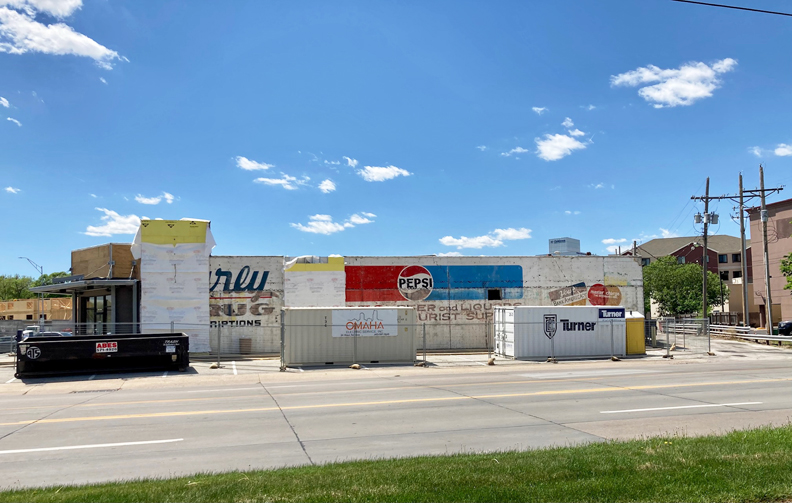
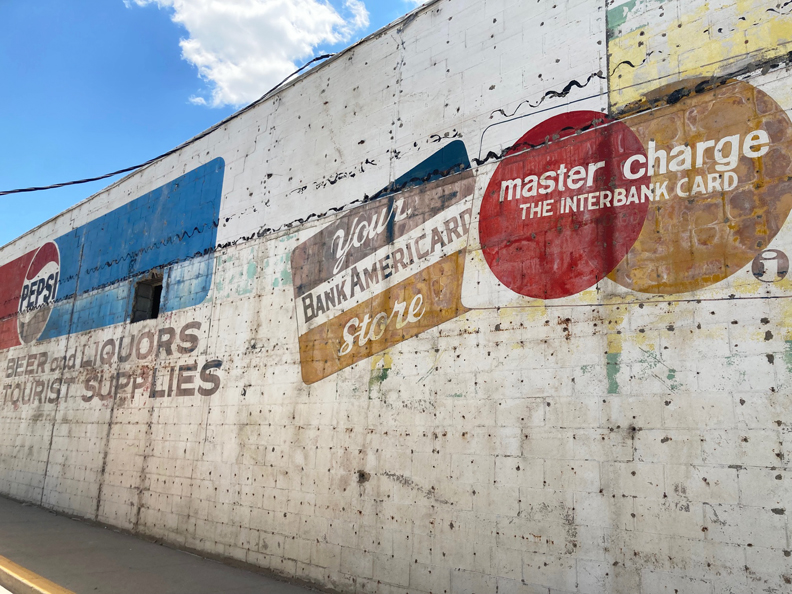
May 16, 2022. I was in love. Who had a hand in this ghost past? The traditional signwriter’s brushstrokes were made evident by the fading. The attention to font style and letter blocking was charming. The little window in the Pepsi sign. The squiggly black glue lines that once bonded to a protective, outer wall.
Friends, this will just be a Light to Medium Stalking Day. Truth be told, I didn’t expend the usual time on interrogation and criticism—just a passing glimpse and some clues I have come across. And of course, some sightseeing. I am fully absorbed in the middle of a major architectural ghost box and parallel-world investigation. In light of the exposed ghost signs, I wanted to share my Varly findings before the wall is sealed up again or altered in some way.
The Beverly Hills Plaza Shopping Center
December 1, 1955 marked the grand opening of the Beverly Hills Plaza Shopping Center. The 750-thousand dollar strip mall was introduced by John P. Mainelli, Sr., head of Mainelli Construction Co. and president of the West Dodge Corporation. The West Dodge group was formed to develop the Beverly Hills commercial project. Early on every Beverly Hills bay carried its own address and the plaza went by “78th and Dodge” but now the property is under 7808 Dodge Street in the Beverly Hills Addition, Lot# 7. Block# 1, to be specific. I won’t include the blacker than black aerial photo the World-Herald used for the strip mall opening. I’ve got to think it was captured in the dead of night, it was so inky. It would make you want to scream like Vampira after you were chauffeured by hearse to shop the new shadowy Beverly Hills by candlelight. Okay, okay, I’ll pop the photo in near the end, just for fun. (On that note, can you believe someone once wrote in to complain that my archival World-Herald newspaper images are sometimes too dark? Darlings, I’ve got to think that’s the way our forefathers and their presses liked to print ‘em here in the Big O. What’s a girl to do?)
It wasn’t until later that I learned in June of 1955 two businesses were raring to go and had opened previous to other tenants moving in. Varly Drug, our point of focus and Socony Vacuum were the early birds.
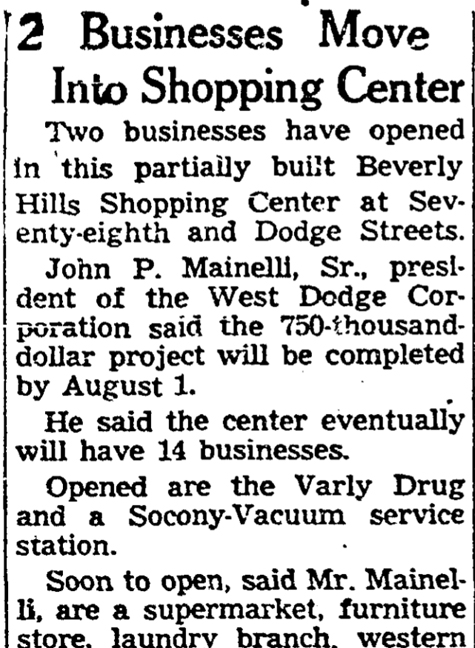
OWH. June of 1955.
Initially the shopping center appeared to be made up of two buildings. The eastern portion next to North 78th Street was wider, no doubt because it was positioned on the wider side of the wedged property. The slimmer, western portion extended to the nearest building, a MobilGas station on North 80th Street. (The Mobil was actually considered part of the plaza, but it was a free-standing building.) At some point they were connected by a party wall and became one, long structure. Study the historic photos and aerials. I see the break between Daniel Furniture and the Big Chief stores. I’d like to hear your take on this two buildings idea.
Upon opening, John P. Mainelli educated on the finer points of the Beverly: Fully air-conditioned center, all but two of the 19 stores and offices were leased and opened. One story, 45 thousand square foot building of concrete blocks and buff colored brick. Free parking for 350 automobiles. Building “has a new type of V-lock joists that eliminate rivets, bolts and welding.” Mr. Mainelli didn’t elaborate on the nerdy things that I like, so I will. As for the building style, I observed there was an assortment of light, buff shades of brick; the building had a flat roof with an aluminum or steel sidewalk awning-canopy that extended from hanger rods. Very on trend right now. It gave a seamless look, clearly MCM. It is evident in studying the historic Beverly Hills Plaza photos that embracing the Mid-Century Modern style, with its elimination of ornament and architectural pretties would keep the construction cost low and therefore highly desirable for a developer. The windows, the doors and awnings all had a light, space age aluminum look. The windowpanes were large and along with the no fuss exteriors, this trick put emphasis on what was within view inside the retail windows. A dark band of stringcourse appeared long and molded, serving to outline the roof for added definition. Was it brick or stone? I am sure it’s still under the current façade.
I didn’t go deep into the history of the Beverly Hills addition in this short investigation but I have in the past. For more specifics on development and platting, please review my previous articles: For the Love of Rose Lodge and Mysterious of Omaha: Hidden House series.
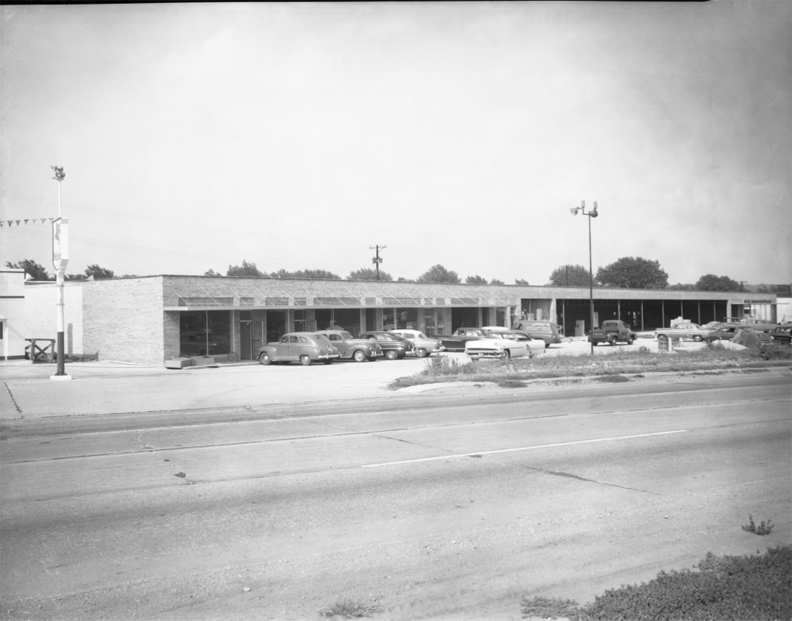
The Beverly Hills Plaza Shopping Center construction began a year previous to the grand opening. 78th and Dodge under construction. Camera faces northeast across Dodge Street, showing the western edge of the plaza. There’s the MobilGas Station marquee to the left. If the dates of the previous OWH article and this photo are correct, that suggests that the eastern-most, wide end of the Beverly Hills, where Varly Drug and Socony Vacuum were located, must have been completed earlier. The H.A. Wolfe Realty Company. Creator: Bostwick, Louis (1868-1943) and Frohardt, Homer (1885-1972). Publisher: The Durham Museum. Date: 1955-08-02.
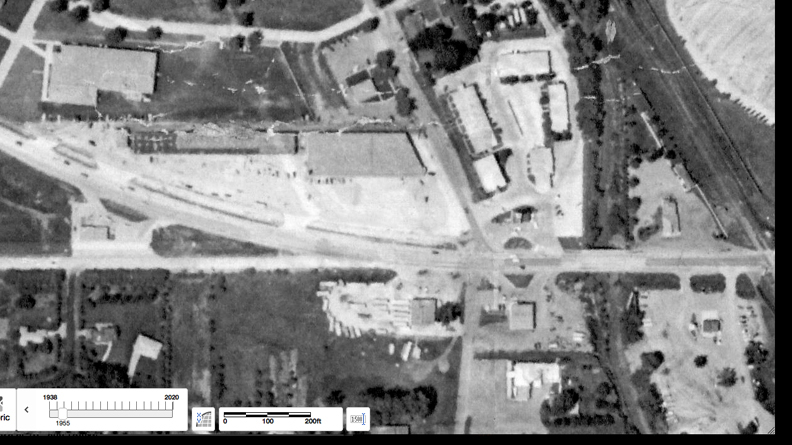
The Beverly Hills Plaza being built. 1955 aerial borrowed from the Douglas Omaha Geographic Information Systems site. Dodge runs left to right through the center of the photo. As West Dodge Road begins to curve upward to the left, so does the Beverly Hills Plaza wedged lot. Notice what appears to be a large space between the eastern and western portion of the buildings. If you are eyeing some locales that you remember, we will review in just a bit.
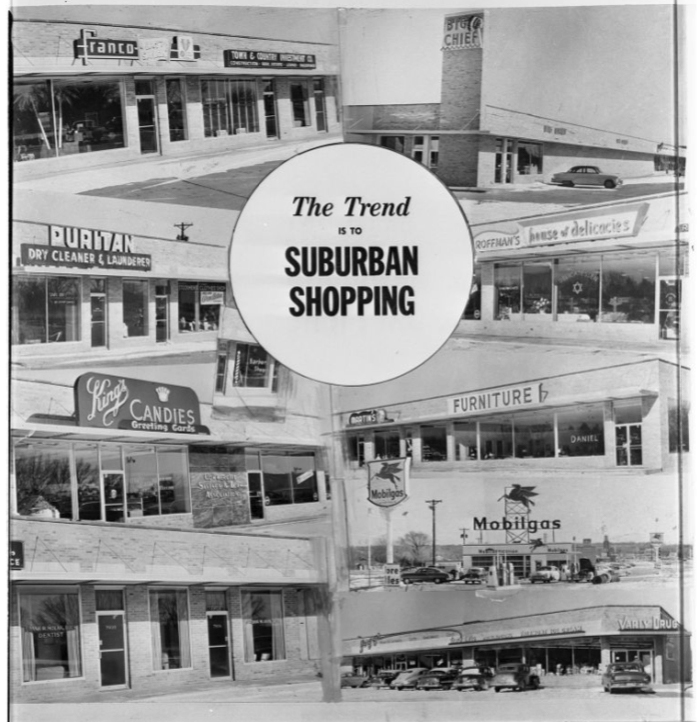
Early advertisement for the Beverly Hills Plaza Shopping Center. The Big Chief Super Market was the largest tenant. Others were early leasers: Yergey Variety Store. George Sevick’s Sevick Western Goods Store, Varly’s Drug Store, Martin Donut Company, Commerical Savings and Loan, Franco Beauty Salon, Willoughby Barber Shop, Daniel Furniture Store, Roffman Delicatessen, King’s Candies company, Town and Country Investment Company, Puritan Laundry and West Dodge Mobil Service. There were also professional offices of Dr. A. W. Abts; Frank Molak, Dentist; and William F. Nolan, Optometrist.
Neighborhood Plazas
Ahhh the lure of the 1950s suburban shopping plaza. When they first made their appearance in Omaha, these shopping centers were often on the outskirts of town—possibly a reaction to the confines of the congested, solid massing of the downtown area. There was a lot to love about downtown Omaha, with its historic, taller buildings. It was the cultural center since white folks settled here. Narrow streets and limited parking were also a part of that picture and Omahans’ changing perception of its downtown was similar to many urban American cities. For Omaha’s part, the housing terrain slowly expands westward to less and less density, the early retail strips largely a part of the neighborhoods until finally, the grid devolves into an unwalkable, endless expanse of one-story, chain retail buildings forecast by government regulation under the name of single use zoning. But I said we wouldn’t delve into critique and here I’ve slipped up. Let me right myself. In my estimation Omaha had small, modern shopping strips popping up along the streetcar line routes on the edges of neighborhoods all along, but as car ownership grew, there was simply nowhere to park–especially with the massive cars of the 1950s and those slim Omaha roads of downtown and midtown. In my summation of things, the 1950s shopping plazas were aiming to create a destination point, where women could attend to all of their retail needs and dreams in one place, the suburbs—just as the downtown area had been to generations before. It probably felt airy and easy breezy and altogether modern compared to the planning that went into the “shopping day” in downtown Omaha.
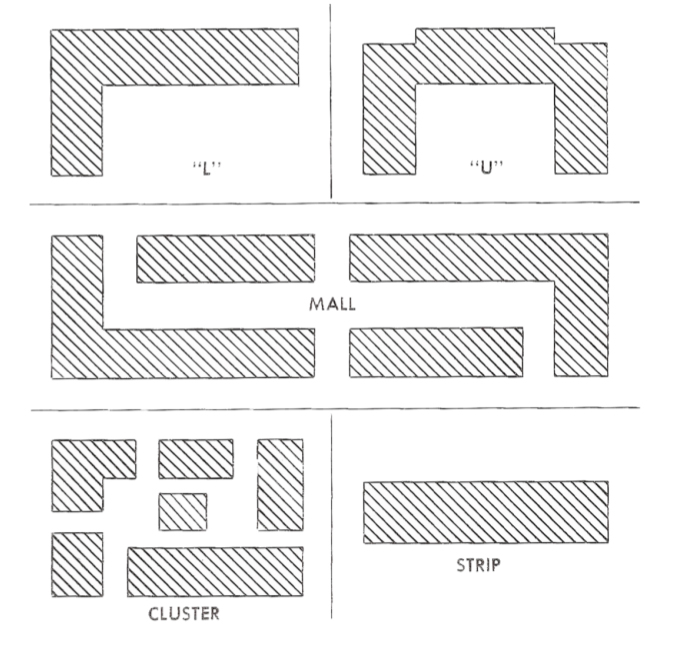
Historic strip mall patterns from Ed. J. Ross McKeever’s The Community Builders Handbook. The smaller size (an Extended Strip, I’ll call it) and ease of construction for Mainelli’s team made Beverly Hills Plaza a great investment. The overall visual was one of long, clean lines. Add in the solid, popular tenants and it was a hit.
Nationally these gloriously minimalist fifties shopping plazas were essentially open-air neighborhood strips–one building in a long row, a couple of structures sharing party walls or other simple configurations such as Countryside Village. There was no need for fuss or fanfare that had been typically found in the town square or downtown area. Unlike the outdoor malls of today, there was no need to create a fountain, a firepit or a little village. People weren’t looking for community or connection in the 1950s; they already had that in their lives. It could be argued that they were trying to escape that intimacy. I slipped on the banana peel again. Okay back to 1950s strip malls. Usually brick or stucco, usually flat roofed. They offered an easy set back with clear visuals from the main road, as opposed to the perceived complication of a downtown area. The strip mall’ s biggest invitation was a large, common parking lot in front or throughout the buildings. They were designed for consumer convenience—a shopping motorist could drive right up to the door of her chosen store or walk leisurely under the sidewalk canopy from door to door. They wouldn’t be renamed and regarded as the offensive, ugly Strip Mall until the 1980s and to my memory, Omaha was not really inundated with them until that time. We were lucky to have fended off the mini-mall concept for as long as we did. The World-Herald wrote in 1957: “Omaha joined the trend toward modern automobile living with the addition of three large shopping centers which provide off-street parking. They are The Center at Forty-second and Center Streets, Countryside Village at Eighty-seventh and Pacific Streets and Beverly Hills Plaza at Seventy-eighth and Dodge Streets.” Yes, yes, dear, I realize that The Center was an indoor mall by definition and not a neighborhood strip mall but it is interesting that these smaller retail structures all sprung up around the same time.
As far as these suburban shopping plazas go, I would say that the Beverly Hills remains my favorite. Countryside Village only a smidge behind. Superb location, clever, clean visibility for being on an angled lot on angled Dodge, good parking but c’mon, first and foremost—I don’t need to remind you that Beverly Hills secured boasting rights to long time tenant B&G Tasty Food’s. That alone, friends, made Beverly Hills Plaza a big hit in the Cassette Family Household. (They say B&G Tasty Food’s will have a comeback out on 90th and Blondo.) Beverly Hills also had the first Zio’s Pizzeria where we punks, a decade later, would go watch our buddy, Dave Brown, flip dough in the air in 1986. There was the little One Hour Photo, the Dick Blick Art Store and the Foley’s Holiday Lounge. Even before I would enter the Holiday, their dreamy neon sign was an eyecatcher. It is with loving obligation to Mr. Cassette’s family that I mention the incomparable Audrey’s Gift Shop, although I never stepped foot in there. (Precious Moments didn’t offer enough coffins and bats for my taste.)
Very Side Note: It came a decade later but The Village Square Shopping Center, sometimes called Pacific Village Square, at 76th and Pacific was an All-Time favorite for both overall design aesthetic and top drawer tenants like the Interlude Lounge, Baskin-Robbins Ice Cream, the Carriage Shop, Pappagallo, and the Baking Company—my first place of employment.
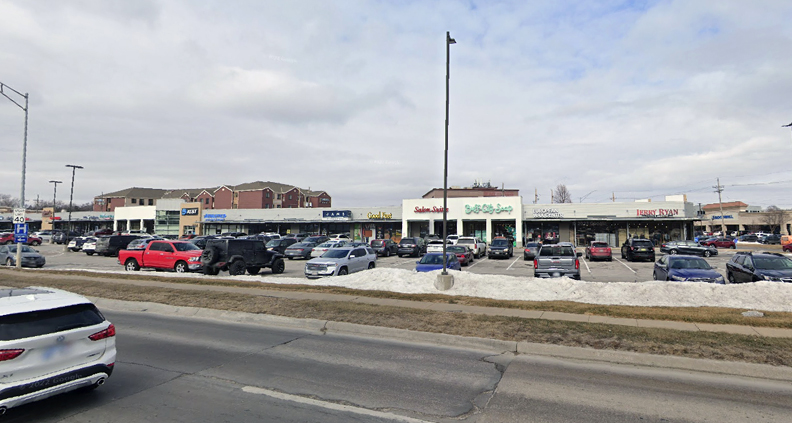
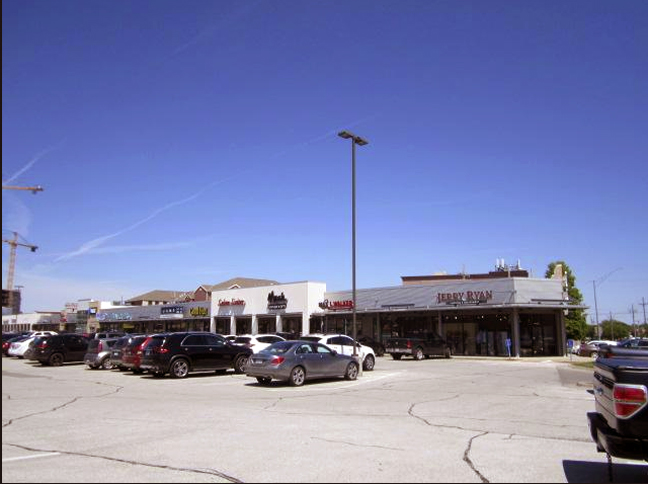
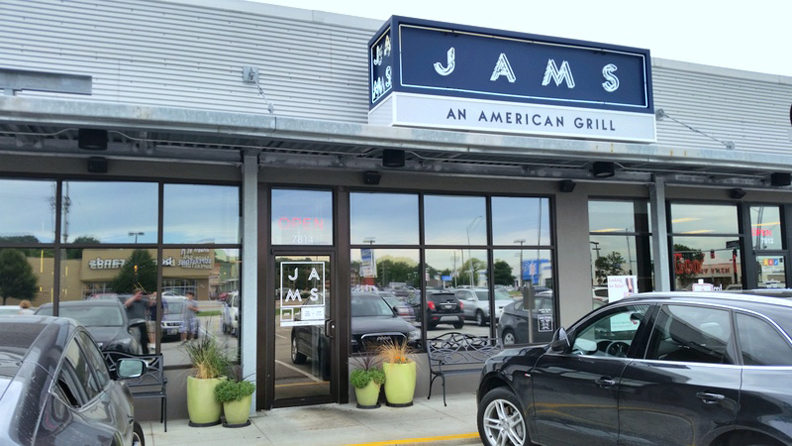
The Industrial Cookie-Cutter days.
It’s true, I have fretted the loss of the wood shake shingle roof and the big globe lights that they dismissed in 2008. I saw that renovation as the beginning of the Industrial Cookie-Cutter Beverly Hills Shopping Center. It lost all personality. Despite it being a popular strip mall, it is not quite sure of what aesthetic it subscribes to currently. Part cattle paneling, blush brick, commercial metal awnings and taller white composite concrete cladding for dimension. It looks like AnyVagueTown, USA. I would argue that the shingle roof offered more distinction as a prominent storefront with strong continuity. The new eclectic renovation has an adverse impact on visibility from Dodge. I have also considered that shake shingle is much more costly and maybe the Beverly Group LLC didn’t want to put the money back into the roof or want to forever maintain such an expensive investment. In that summary, I am in touch with the reality that facades are meant to come and go like the commercial trends and that the shake roof was also a fad that had had its day, to some people’s taste. So let it be known, way out to 90th Street, that Shake Shingle Beverly Hills was a much-preferred aesthetic in my book of account.

The Dixie Kitchen! There it is, folks back in 1981. The Dixie Kitchen had a southern style, white, front-gable instead of the shake shingle. Interesting. And there’s that 1960s Colonial lamppost that I’m obsessed with. Did that sign rotate on the roof? Max I. Walker is in the foreground. The Dixie was one door to the west of Varly Drug and you can spy it on the far corner. The New Tower Inn is seen across the street. Image borrowed from OWH. 1981.
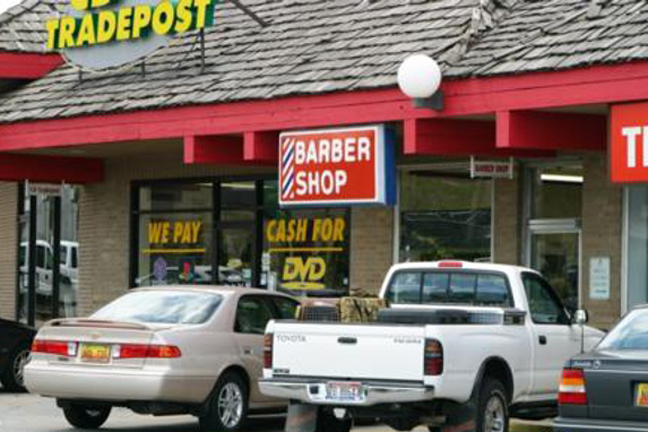
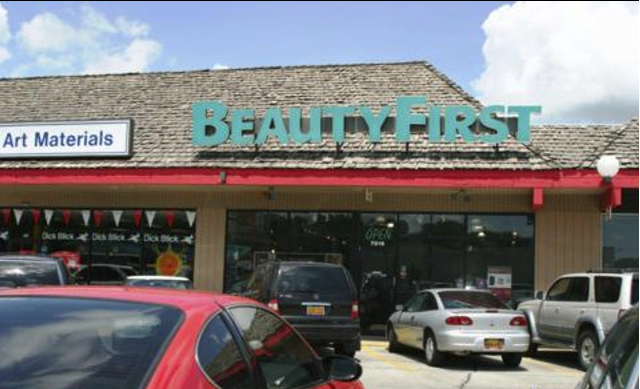
Out with the old. I believe this heavy shake and globe lighting dated back to the Beverly Hills’ early 1970s, minus the red accents.
The Neighbors
I am dying to show you the photographic clues to the Beverly Hills Plaza Shopping Center but before I take you down that winding path, we need to discuss the neighbors. Yes, lean in. We’ll be whispering for a while. Beverly Hills Plaza upholds an excellent location but back in 1955, it was surrounded by true Omaha institutions, as well as some colorful one-offs. Now I will confess I’ve made a somewhat disturbing display of weirdo arrows but you should only concern yourself insofar as to understand that I really don’t know how to use Photoshop.

1955 aerial of the Beverly Hills addition. Camera faces north. Creator: Savage, John (1903-1989). Publisher: The Durham Museum. Date: June of 1955.
From left to rightish:
Yellow arrow was the General Motors Training School. Purple arrow is the Beverly Hills Plaza Shopping Center.
Green arrow points to the Tower Motor Court.
Blue arrow points to the 76 West Dodge Drive-In.
Red arrow points to the Rose Lodge restaurant.
In background and foreground are housing developments by several realtors and builders.
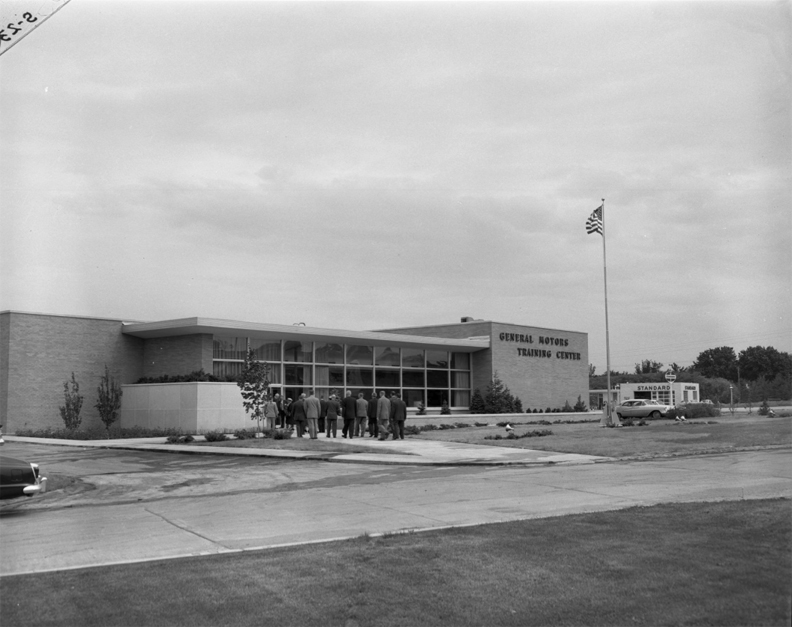
225 North 80th Street was originally built as the General Motors Company training school for its salesman, dealers and service men. This was also a very Mid-century Modern flat-roofed building and I remember it faced west. I don’t know why this one was on my radar as a child but I thought it was pretty cool and it’s remote positioning intrigued me. The million-dollar school was proposed in 1954, construction completed in 1955. This was one of 35 training schools built by GM in the country. The General Motors Training Center building. A group of men is walking into the building. Creator: Savage, John (1903-1989). Publisher: The Durham Museum. Date: June of 1955.
The GM Training Center building was later bought by Vatterott College, a for-profit college and transitioned to their “Dodge Campus.” Vatterott College officially folded up in 2018, but they had left this location years earlier. Interestingly in 2008, when the Beverly Hills Plaza began their major facelift-renovation and tore down the shake shingled roof, they had a plan for the General Motors Building. In addition to leveling the west end bay of the plaza, Play It Again Sports, they would also raze the General Motors building. Their idea was to create a new “80 Dodge Building” west end cap of the plaza property. KETV reported the City said that 80 Dodge would “Lead Midtown Development.”

Photo of the proposed 80 Dodge building at the site of Vatterott-General Motors. Construction was to embark in November of 2008. I would love to see new residential with this many windows in Omaha.
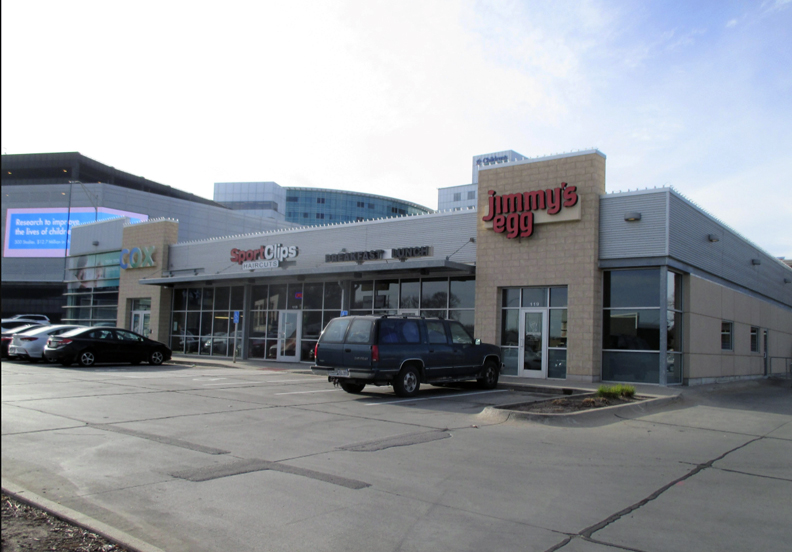
Something must have fell through with that plan because an extension strip mall (east facing) was added on the western end of Beverly Hills Plaza. Although freestanding, this new building mimics the eclectic design of the current Beverly Hills Plaza. There is also a northern one-story strip that has been added as well.
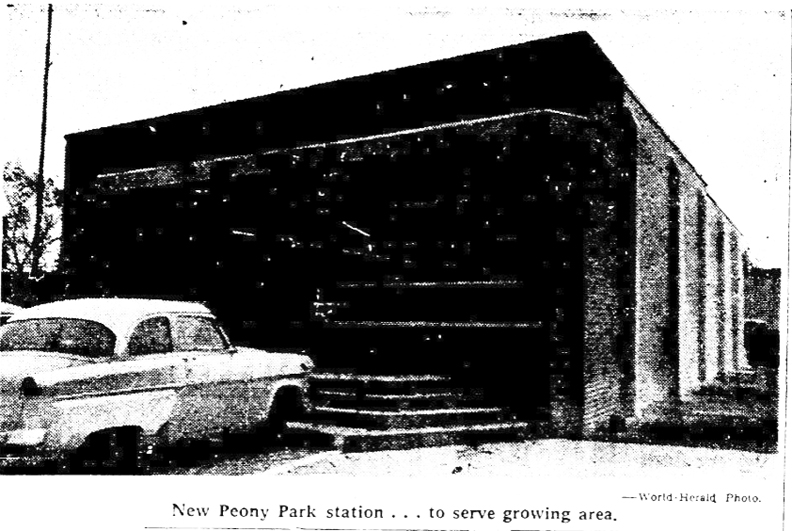
In November of 1957 a post office was built at 78th and Davenport, directly north of the strip mall and was considered as part of the Beverly Hills Plaza. It was known as the Peony Park Postal Station. It was a classic, MCM 1950s style, one-story postal building, built on the quick “to serve the ever-growing population in Omaha’s western area.” Unfortunately this station is now gone, replaced by the tall, mysterious Firm Group building at 210 North 78th Street. Image borrowed from OWH. November 1957.
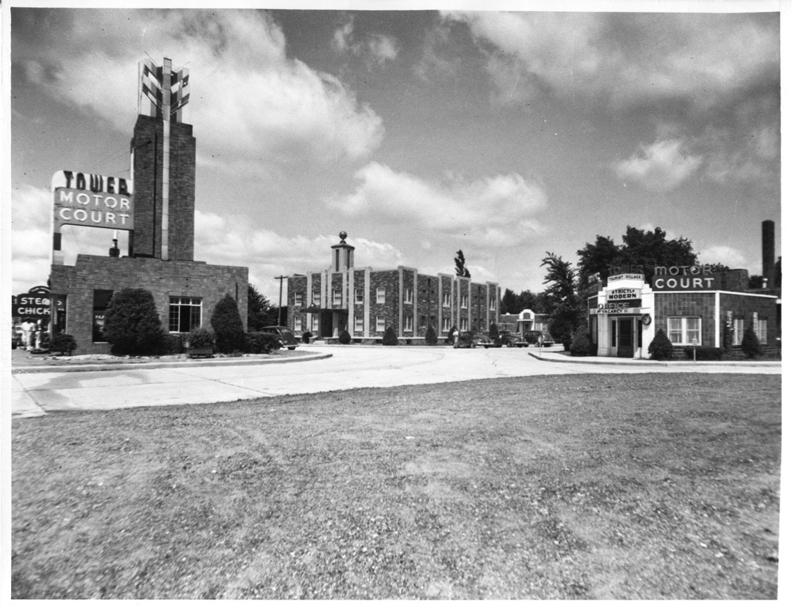
Across 78th Street to the east was the Tower Motor Court, as it was called in the 1950s. The motel had originally opened in 1936 as the Tower Tourist Village, a convenient place to stay for visitors in town for Peony Park amusement park. The Tower Tourist Village was the invention of Joe Malec, of Peony Park fame, along with partner, Frank Blazek. The property extended from Dodge to Cass Streets. Exterior view of Tower Motor Court. “Tower Motor Court.” “Tourist Village.” “Strictly Modern.” Creator: Donated by Peony Park / Joseph Malec III. Publisher: The Durham Museum. No Date.
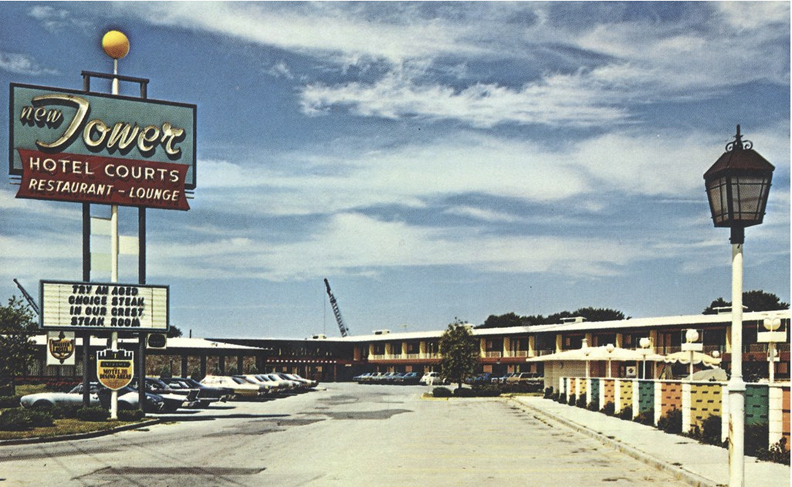
In my punk teenage years New Tower Inn, as it was later called, was the focal point of some constant oldster-lounge teasing, as the whole place seemed to cater to a pent-up nightprowl crowd. Frank Blazek’s nightlife offerings did seem to mirror the various SNL’s piano lounge parodies but my, did Blazek draw them in. Of course I would come to realize all of the New Tower Inn’s bars, restaurants and regulars were Very Cool, as I got a bit wiser. Thank the moonless nights I stopped wasting time hanging around graveyards and got to take in the sumptuous sounds of the Two of Diamonds and enjoy the fabulous interiors throughout the place. The New Tower was demolished in the late 1990s. New Tower post card: New Tower Hotel Courts – Omaha, Nebraska 78th & Dodge St., Omaha, Nebr. 68114. 350 rooms with direct-dial phones, hi-fi radio, color TV. Sauna baths. Delicious meals in our Crest Steak Room & Frontier Coffee Shop. Lazy Leopard & Bird Cage Lounges for fun. Comfort – Warm Hospitality – Fine Food A Master Hosts Motel.

The 76 West Dodge Drive-In was located at 7646 Dodge Street. It initially opened as The Drive-In in 1948. A year later it was refashioned as the West Dodge Drive-In. By my father’s day in 1952 it had again transitioned to The 76 West Dodge Drive-In. I have no memory of this drive-in. Sadly it was closed and leveled by 1983. West Dodge Drive-in Theater, Dodge Street, Omaha, Nebraska; ca. 1980. (Photo by: HUM Images/Universal Images Group via Getty Images).
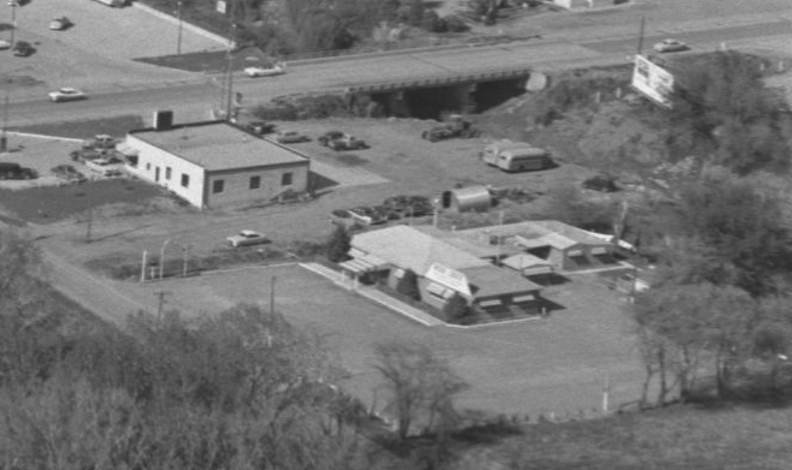
Rose Lodge was a beloved Omaha restaurant. It is the second structure, two doors down from the southeast corner of 78th and Dodge Streets. Its entrance faced west. Detail of previous photo. Creator: Savage, John (1903-1989). Publisher: The Durham Museum. Date: June of 1955. I have written endlessly about it both on this website and in my book. I will spare you the rehash. Here is that deep investigation, if you missed it the first time through: For the Love of Rose Lodge.
Look Book of Early Beverly Hills Plaza
I do enjoy these 1955 photos of the Beverly Hills Plaza. I think they give a good idea of simple, clean lines of the 1950s suburban strip design, in addition to a solid combination of varied, winning businesses. It is also important to remember that this was an up and coming suburban neighborhood. There had always been both nice country and palatial homes out and sprinkled around Dodge but the residential platted developments were new to the terrain. Fresh tract housing is seen dotting the landscape in the aerial photos at this time. For the preceding years, this was primarily rural and a tourist and entertainment area on the highway, the fringes to Omaha. Regional success Peony Park was directly to the north on 78th and Cass Streets. The Tower Motor Court was just across North 78th Street to the east. The 76 West Dodge Drive-In was a few doors down at North 76th Street and Dodge Street. Omaha Famous Rose Lodge was a straight shot to the south on 78th Street. These three intersecting factors of great, diversified business, the popularization of the western suburbs and location within an established entertainment area had to have clenched success for the new Beverly Hills Plaza. Just my thoughts.
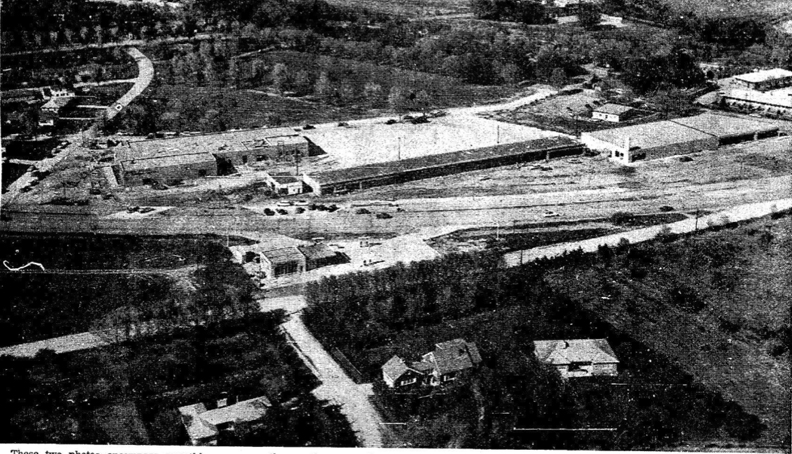
Is is neurotic how much I obsess over aerials? Don’t answer that. I hope you love them too. An aerial view of the land near 78th and Dodge streets. Our Beverly Hills Plaza is being constructed, seen on the north side of Dodge. Note the seeming space between the two parts of the building. Houses are going in to the north of the strip mall. Creator: Savage, John (1903-1989). Publisher: The Durham Museum. Date 1955-05.
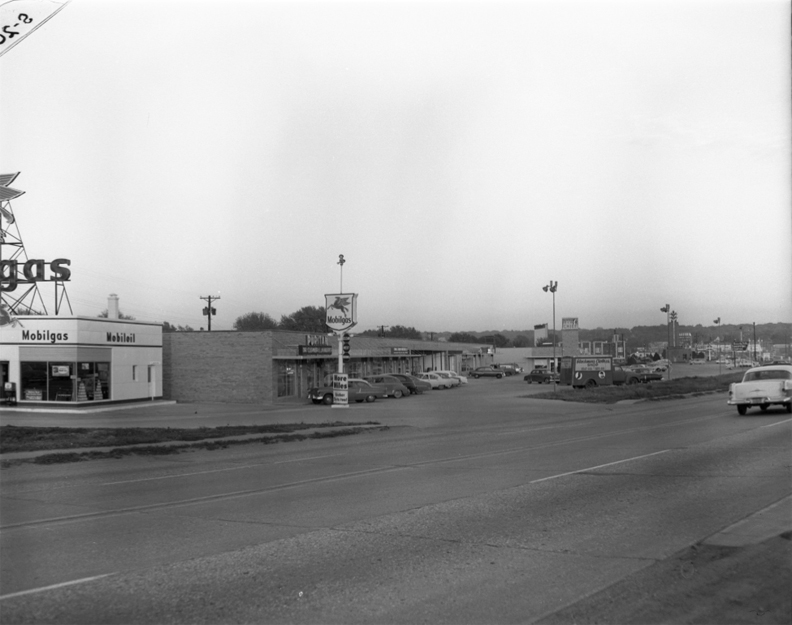
Great image of the far west corner of the simple, low profile Beverly Hills. MobilGas on the left peak. A look to the east on Dodge Street. Creator: Savage, John (1903-1989). Publisher: The Durham Museum. Date: October 1955.
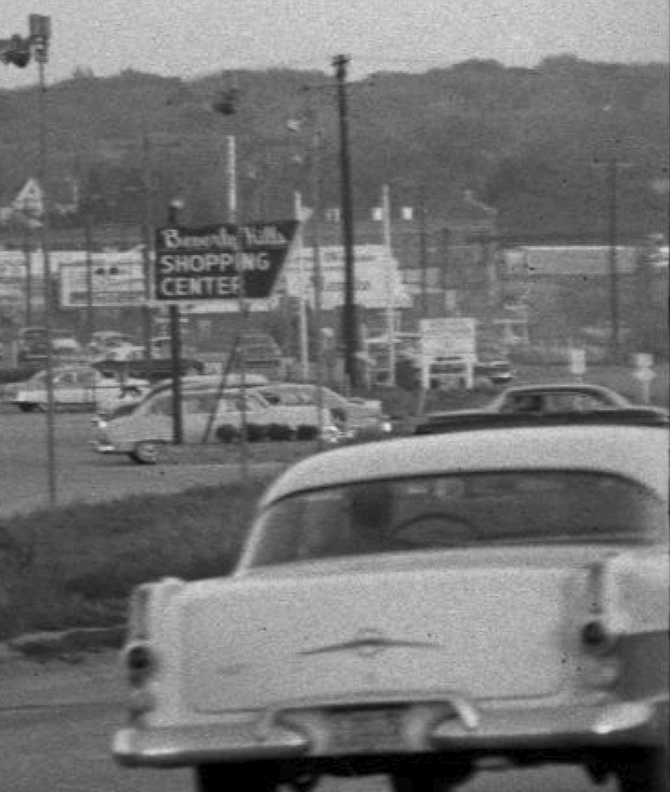

You know I had to magnify the cool 1955 Beverly Hills Plaza Shopping Center marquee and car. 1950s Omaha’s subdued Googie. And here’s an illustration of said signage I found later. Yum. Did the West Dodge group change it or did the advertiser have an artistic moment? My good buddy, Syd Reinarz identified this 1955 Pontiac for me. Ginchy!
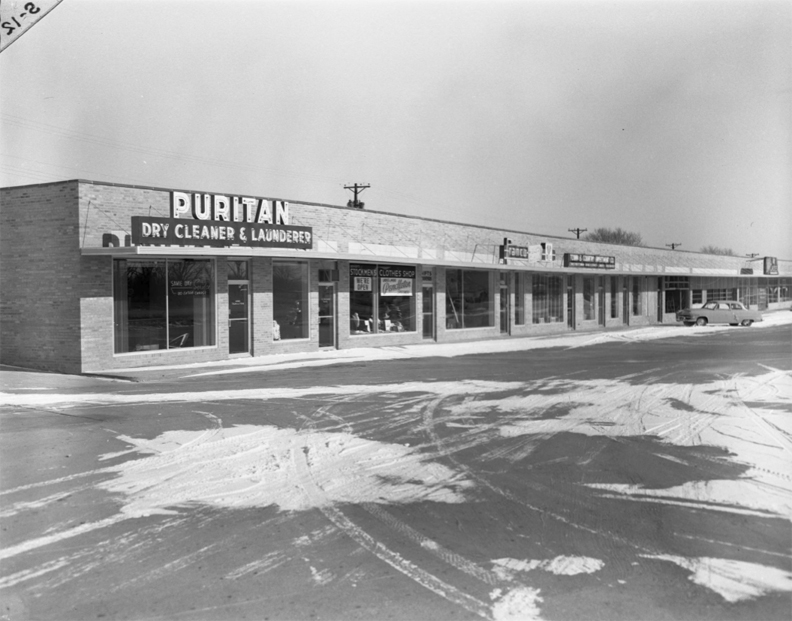
First bay in the strip, starting on the left side. Puritan Dry Cleaners in the Beverly Hills Mall. Next door to the east is a clothing store. I am not sure if it is George Sevick’s Western Goods Store or another. Creator: Savage, John (1903-1989). Publisher: The Durham Museum. Date: 1955-11
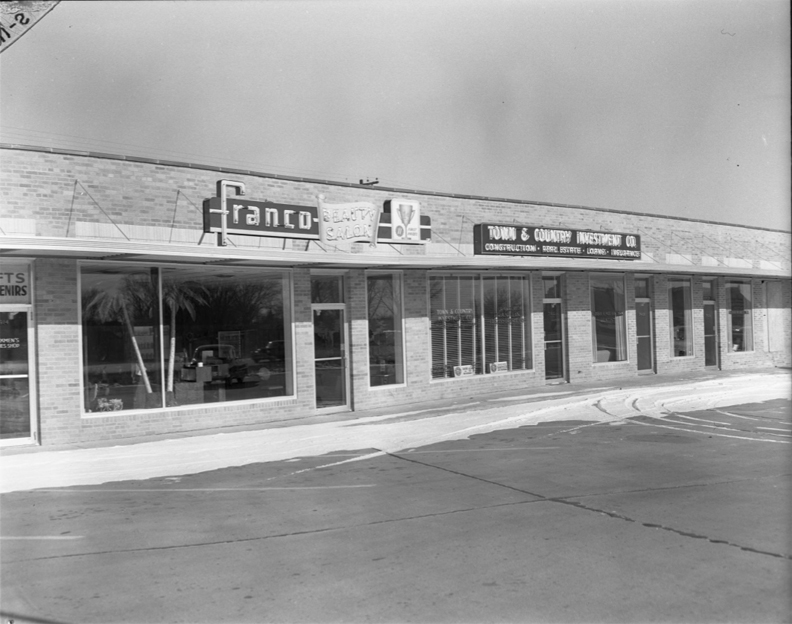
Let’s hear it for the “prize winning” Franco Beauty Salon. They had the best ads but because of time and space constraints, I didn’t include them all. Amazing! Next door is the Town & Country Investment Co. Creator: Savage, John (1903-1989). Publisher: The Durham Museum. Date: 1955-11.
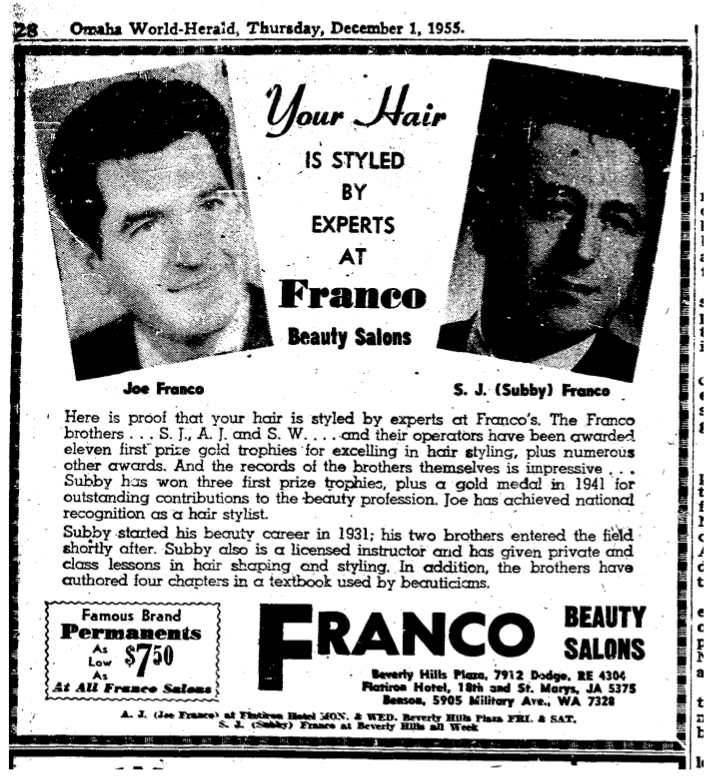
Well let me add just one. December 1, 1955. OWH ad. I am including this for My Omaha Obsession buddy, Kevin Rose, in memory of his family. His uncles Joe and Subby Franco are highlighted in the advertisement.
**Addendum of 2022** Joe Franco’s nephew, Kevin Rose, wrote in and shared these incredible photos of his uncle. They give an even better view of what the Beverly Hills Plaza looked like in its salad days. Here is Joe Franco now, in his fantastic Cadillac Eldorado in front of the Puritan Dry Cleaners and Franco Beauty Salon with additional scalloped awning added; the second image shows what the Town & Country Investment Company looked like. Joe and Subby, brothers, owned the Beverly Hills Franco Beauty Salon location. Franco family photos shared by Kevin Rose. Thank you!
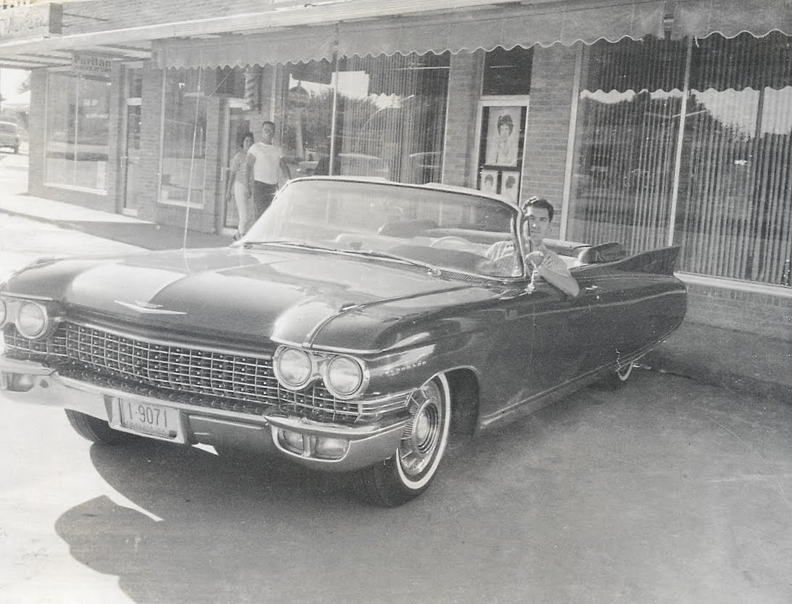
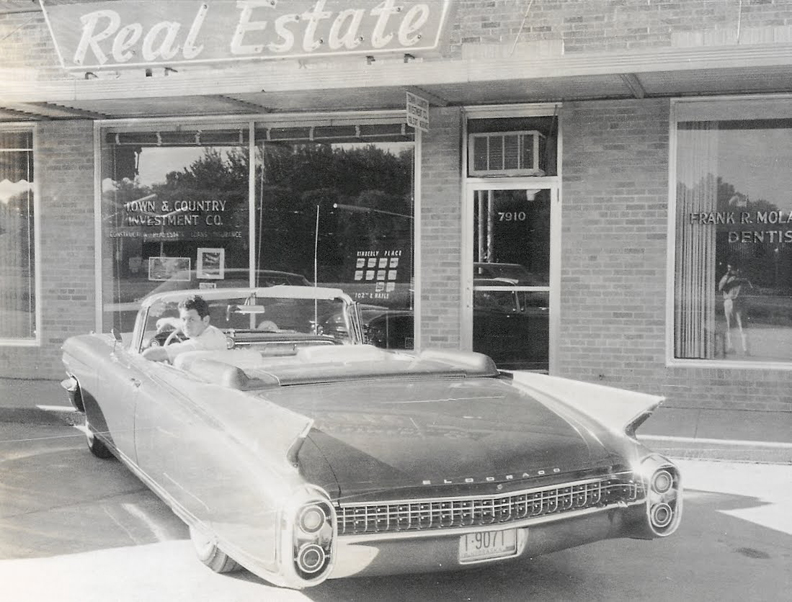

Candy and Greeting Cards? Two of my favorite things. King’s Candies in the Beverly Hills Mall. Classic neon. Next door is the Commercial Savings & Loan. Creator: Savage, John (1903-1989). Publisher: The Durham Museum. Date: 1955-11.
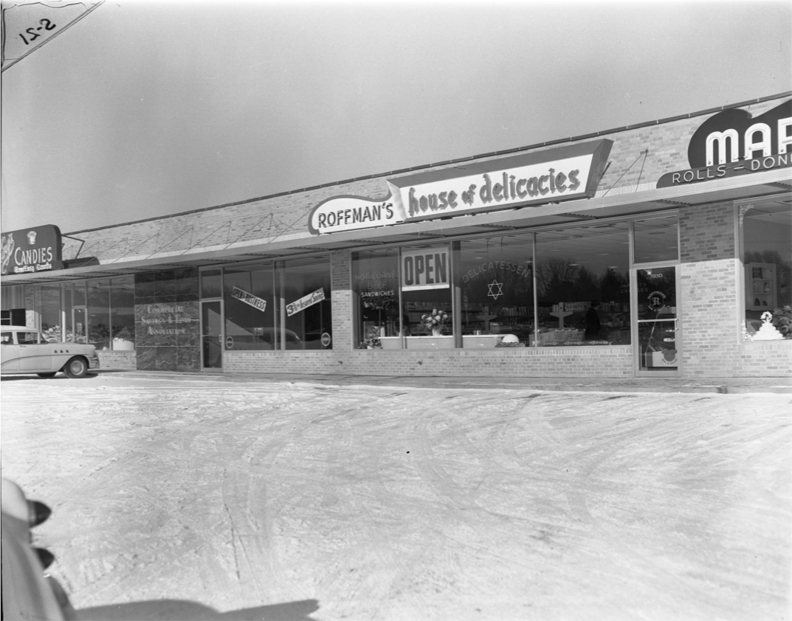
Next up is Roffman’s House of Delicacies in the Beverly Hills Mall. Now I have heard from my pal, Carl Ashford, that this place was very, very good. A real Jewish delicatessen. I should have liked to have tried this one! Creator: Savage, John (1903-1989). Publisher: The Durham Museum. Date: 1955-11.

Martin’s Cakes and the Daniel Furniture store in the Beverly Hills. This furniture store marks the end of the western strip. Notice what looks to be the exterior wall of the building, before the Big Chief grocery store begins. Creator: Savage, John (1903-1989). Publisher: The Durham Museum. Date: 1955-11.
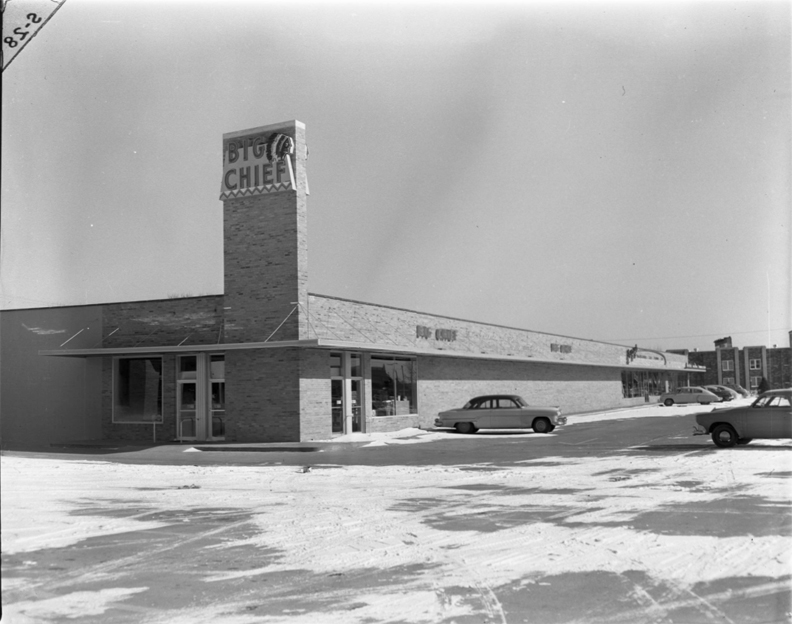
The Big Chief Supermarket in the Beverly Hills. This was considered the anchor store of the strip and as once can see, it was a larger grocer. Again it looks like the western wall is an exterior one—revealing a space between the two portions. On the far east, across 78th is the early Tower Motor Court—later to be the New Tower Inn. Creator: Savage, John (1903-1989). Publisher: The Durham Museum. Date: 1955-11.
And lastly, on the far eastern end was Varly Drug. One of the first businesses to move into the new plaza…
Varly Drug
Upon opening in the Beverly Hills Plaza, Varly Drug was described as a “Beautiful Deluxe Drug Store.” They offered, “Complete Drug, Cosmetic and Coffee Bar.” Not a soda fountain, kiddies, a coffee bar. I am there.

Varly Drug Store in the Beverly Hills Plaza. Creator: Savage, John (1903-1989). Publisher: The Durham Museum. Date: 1955-11.
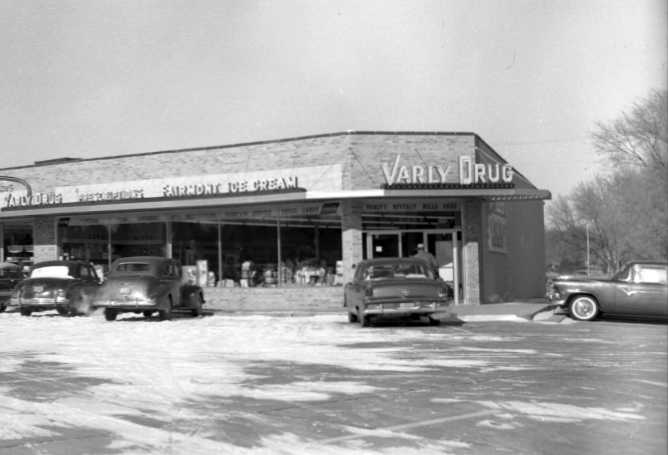
The details: Like the traditional pharmacies, drug stores and corner stores of the past, there was only one public entrance to Varly Drug, placed directly across the corner angle to be viewed from the crossroads. This is paramount and I love that attention to detail. Even though the Varly druggist was moving into a modern strip mall, he or the architect upheld a tradition. At the very least, it was charming. Also under scrutiny—I am not able to detect the current menagerie of hand painted advertising on the east wall but it does look like there is a hanging sign and above it, a painted sign, possibly offering a “V.”
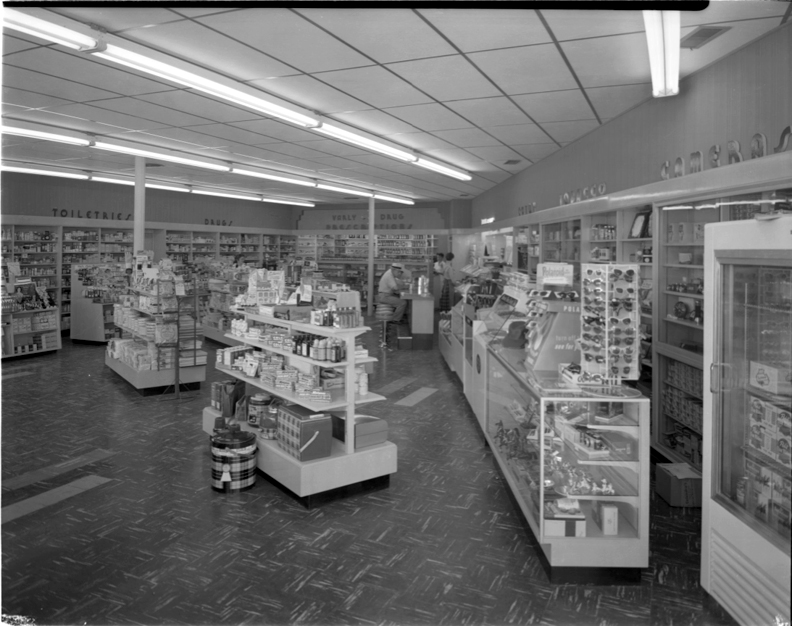
I would love to get a gander at those sunglasses because the 50s shades were the best. Don’t you agree? I pray that the linoleum floor was red. It looks almost exactly like our 1940s basement rumpus room. I suppose that would be a bit psychotic for a pharmacy. Interior of the Varly Drugstore at 7808 Dodge Street. There is a man sitting at the counter but don’t call it a soda fountain. Title: H.A. Wolfe Realty Company. Creator: Bostwick, Louis (1868-1943) and Frohardt, Homer (1885-1972). Publisher: The Durham Museum. Date: 1955-08-02.

So I had to colorize the photo because the linoleum floor tiles were getting to me in the middle of the night. I needed to know. These online sites for magical colorization are a bit like a mood ring or invisible ink or anything wonderful, but the point is, the floor was brown. Brown linoleum. Does anyone else out there wonder why there was so much orange on display in the drug store? I think the colorization method wasn’t picking up much variation. That or they were in perpetual autumnal décor. Why, even the man back at the coffee bar is orange. My word.
This was back in the time of elevator girls and fountain ladies. Varly Drug required young male clerks, preferred light deliverymen and stock boys and clean, tidy, female cosmetician clerks.
I would find Varly Drug had previously been located at 2916 Cuming Street in 1951. This location had been operating off and on as a drug store since the early 1900s. Varly took over from Pharmacist Thull between 1949 and 1951. Had it not been for a defective ice cream freezer motor starting fire in August of 1951, I might have missed that Varly Drug had been in business years before their Beverly Hills venture. By October of 1956, this Cuming location had become Tromler & Son Television Sales and Service; Varly Drug had already transported to Beverly Hills Shopping Center by June of 1955.
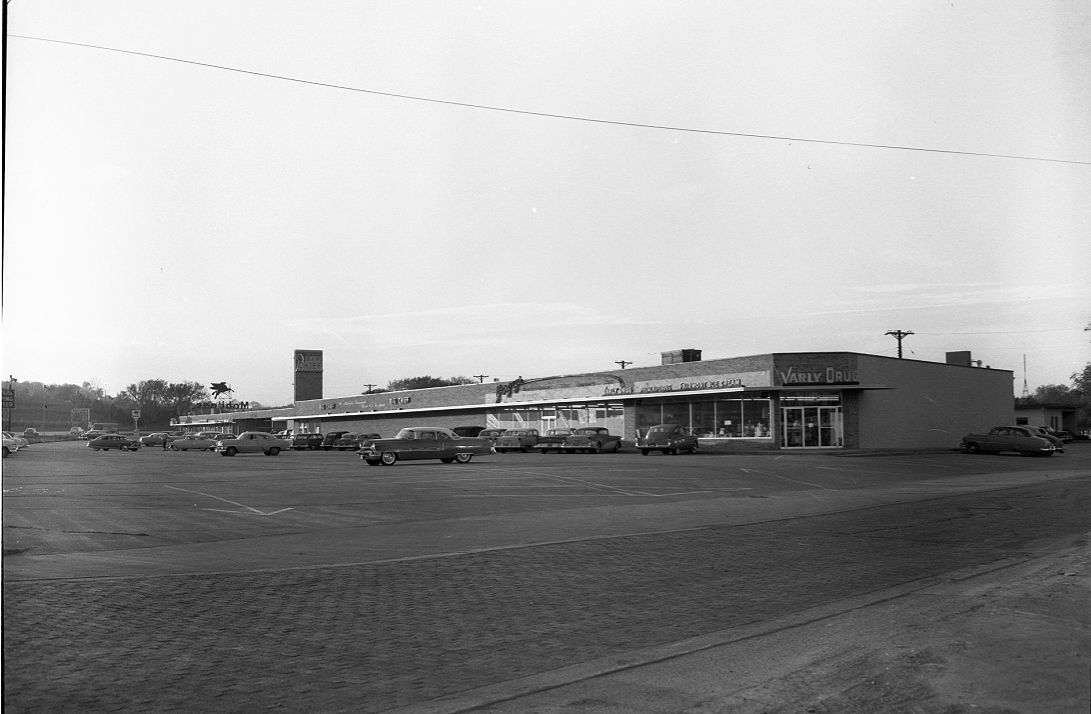
Another great photo of Beverly Hills Plaza Shopping Center—this one giving a long expansive view of the whole strip for 78th Street, looking west. One can see that that parking lot might have been a real enticement to modern automobile shoppers. Creator: Savage, John (1903-1989). Publisher: The Durham Museum. Date: October of 1955.
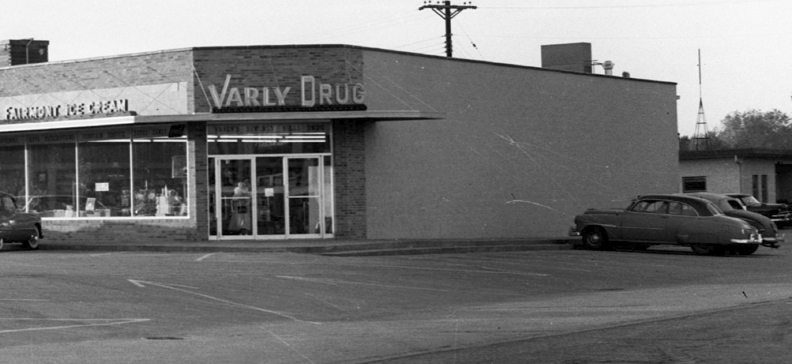
Detail of clear eastern exterior.
The Varlamoses
I was confused and then entertained to find the press and even their own advertising spelled out Varley Drug just as often as Varly Drug. I will come clean that even my file folder is mislabeled Varley Drug. Once I found the photographic proof of the formal store sign, I thought I’d nailed it down. I thought Poor Pharmacist Varly and his cosmetician clerk wife, Mrs. Varly. No. I was wrong. If this May of 1955 off-sale beer license application for Leonard J. Varlamos hinted at anything, Varly was a nickname or a humorous spinoff of the surname. Was Varlamos a pharmacist? It seemed a cinch of a nickname the more I considered it, but everyone’s got a different spelling of a nickname, and I suppose that might have been the issue.

Beer Hearing. Leonard J. Varlamos Filed for beer license. May 1955. OWH. By the by, the beer license was no problem. The package liquor license, however, was denied in August of 1956 along with Roffman’s House of Delicacies, the Countryside Pharmacy and the Wishbone Restaurant at 7600 Dodge. It was noted that eight of the nine denied licenses were for businesses “on the western edge” of Omaha.
I would get on the trail. In June of 1941 Iowans Leonard James “Varly” Varlamos and Dorothy Irene Eaton, both 21 years of age, filed for a marriage license in Omaha. Just the year before Leonard was counted in the 1940 U. S. Census living at the home of his parents in Denison, Iowa. This logging would reveal that his parents, James and Lena, were immigrants from Greece and Denmark. The young newlyweds lived in a pressed brick rental house at 2224 Cass Street, later torn down by Creighton University in the early 1970s. His World War II draft card shows that Varly registered in February of 1942 while in the employ of the Union Pacific Railroad; he served in WWII with the Army Air Corps from December of 1943 to January of 1945. When he left service, the Varlamoses bought property in the Tukey Heights addition. Platted in 1906, A. P. Tukey & Son developed their 50 lots on about fifteen acres at 36th and Grand Avenue. Varly later graduated from Creighton University with a degree in pharmacy. As I had previously mentioned, the couple was able to open the first Varly Drug by at least 1951. By the 1950 U. S. Census the couple had son, James, who was eight years old. They had another son named Donald, although I am not sure when he was born. The family had set their gaze on the popular Ridgewood addition. Subdividing ever westward, Shuler & Cary easily promoted their Ridgewood and Loveland developments on the West Pacific Road in the 1920s, as families desired to live outside the city limits. Varly and wife purchased their Ridgewood home in February of 1955.
It is often a sad state of affairs trying to dig up information about women from this time period. I was pleased to find some clues about Dorothy. She had been an active member of the Creighton Pharmacy Wives Club. Years later, I would find Dorothy Varlamos of Varly Drug fighting Omaha’s “Sunday Closing” ordinance in an appeal to the State Supreme Court back in October of 1962. There were eight druggists who brought the first lawsuit attacking the Sunday sales ban but they did not ultimately seek a new trial. It took a while to figure out but Dorothy was by then the owner of Varly Drug. For all I know, Dorothy might have owned Varly Drug all along. There is one thing family business owners know and that is that every family member, including children, is effected by the business, whether they are actively participating or not. It takes a tremendous amount of time and devotion to make it work.
Surprisingly Dorothy had been granted a divorce from Varly back in October of 1958. My question is, was Varly still the pharmacist of Varly Drug under Dorothy’s reign or was there another druggist? She would marry Jack Zeigler in 1966. By 1967 I discovered our man Varly was living in Waterloo, Iowa where he would own a greeting card shop and later owned and operated a motel in Jesup.
John’s Varly Drug
At some point Dorothy Zeigler sold Varly Drug to John Truscott. Truscott helmed the existing corner business from there on. I found as early as 1976 that Varly Drug had transitioned to the John’s Varly Drug name. Well sometimes…honestly, it was oft known as John Varly Drug and sometimes still Varley’s. I understand that it’s hard to ensure the spelling of nickname, let alone one’s predecessor. By the 1980’s the corner drug had fallen under the handle of John’s Pharmacy. It was all a muddle on the trail. John Truscott was a local pharmacist, having graduated from Creighton University’s Pharmacy school, just as the previous owner. In this pharmacy acquisition, Truscott most likely secured all of the Varly prescription patients and a good deal of foot traffic, as well. It appeared his business was successful. John and wife, Phyllis, had seven children and for that I tip my hat. As I said earlier, a family owned business with that many children would be a challenge for the whole lot of them. Before John bought Varly Drug, I found he was deeply involved in thoroughbred horse breeding as well as racing. The articles let on this was obviously a true passion of his.
As to the corner store, like many pharmacies in this time period, Varly Drug had stepped up its package sales. Unfortunately Varly Drug, like other drug stores, was met with all too frequent hold-ups in the 1970s and 80s. It became a truly dangerous business for some.
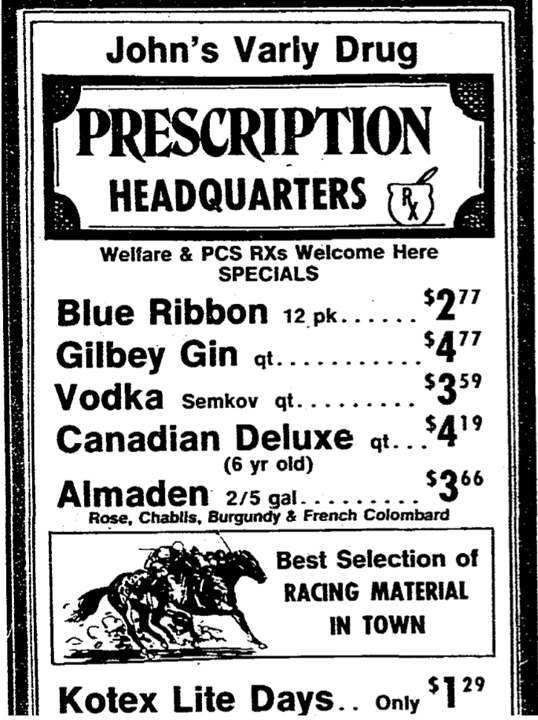
June 22, 1978 advertisement. OWH.
John’s Varly Drug was seemingly in business until at least late 1986. Phyllis and John Truscott divorced in July of 1987. In October of 1987 I found Big John’s Inc, Varly Drug, and John’s Varly Drug filed Chapter 11. (There was a Big John’s Pharmacy on West Broadway in Council Bluffs in the late 70s—was this the same pharmacist?) I know from my other investigations that this was a difficult time for small pharmacists and that little, neighborhood pharmacy businesses as a whole, suffered with federal and state regulations and insurance changes, let alone the big franchises taking over the majority of customer business. I was touched to learn that both of the Varlamos and Truscott marriages and Varly Drug ended in this way. But life goes on, as they say, and for John Truscott, the thoroughbred enterpriser–he moved to Minnesota in the early 1990’s and continued to practice pharmacy until his retirement in 2005.
Brief History of Sign Painting
Hand-painted signs were common advertising found on buildings, billboards, shop windows, banners, barns, trucks, walls from the 1880s to the 1950s, in a time when there were not a lot of rules about commercial messaging. Created with brushes and paint, these local sign painters usually learned their tricks of the trade through apprenticeship, a long on-the-job introduction to the materials and tools. The lettering brush was particularly difficult to master and therefore there were less signwriters (lettering done freehand). Sometimes these sign painters were called Wall Dogs.
A ghost sign is named such only after its aging process begins. To many of us, this fading, thinning, milky, smoke quality is inherently more interesting, than something brand new, as brushstrokes and the underpinnings of the initial work up is exposed. For example the sign writer’s original plan or markings exposed. The additional thrill, and in my opinion, adding a haunting quality to the namesake, is that these images have been hidden and there’s a reveal from behind a wall, covered over old renovation or an inner wall. I think another part of the ghost name is that as methods of creating sign changed over time, the painted sign became less durable and therefore ghost signs from the late 1960s on are less common. It is a rare haunting. Some of us will always prefer the human touch over computer-generated signs. I love the flaws. I embrace the imperfections that can only come when humans are involved.
Advertising painters and sign writers have always worked a trade and there was no confusion that their product was high art, but there was certainly an artistry and refinement to this craft when done well. Omaha had a Sign Writers Local No. 752 union for decades. Long ago local Cronland Signs was a solid name in signage. The business offered everything from truck lettering to gold leaf on office window doors. A signwriter would begin in a four-year apprenticeship. I found advertisements from late 1938 when the Printasign Machine came on the market that boasted of replacing “high priced sign writers.” From that period on, even before the invention of computers, ads could be inexpensively mass-produced with these large printing presses and replaced as a retailer saw fit. Then in 1957 five bills were introduced to the House of Representatives to try to curb billboards and advertising signs from along the new Federal Interstate Highway System. Motorists and nature lovers didn’t want the massive ads blocking their views. Advertising companies, organized sign painters and others felt their jobs were at stake.
Hand-painting became even less and less popular since the 1980s. This is when computers had their entrance. They were able to print those hideous vinyl signs cheaply and quicker. And for this reason, they’ve never gone away although I’ve quietly prayed for their exit. I dream of a world where Cris’ Kohll’s Pharmacy will stop hanging these vinyl signs off of their building at 50th and Dodge.
Let us examine the ghost sign clues on the Varly Drug wall.
My Walkabout

The original 2015 exposure. The other images to follow are from May 16, 2022.

“656”—must know more!





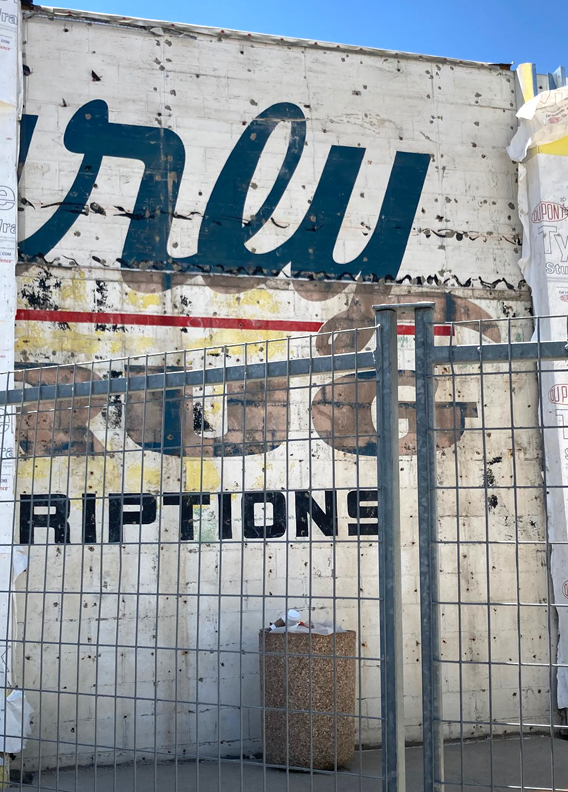
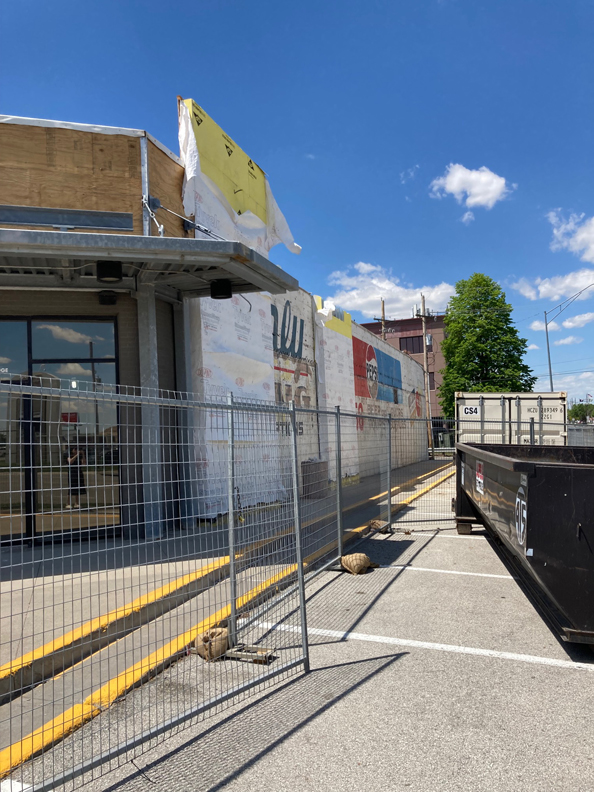
Mural Investigation
I would very much like to hear your thoughts. Here’s what I got, boys and girls. I was originally of the belief that the Varly Drug portion of the wall was the initial painting. Stylistically it looked older to me; its quality of paint and confident application seemed stronger than the rest of the images. I dated this portion to the late 1950s or early 1960s. Its proximity to the front door and stand alone framing, signaled to me, that this could have been an earlier individual job and the rest of the wall might have been a solid white.
The Pepsi sign throws me off. It seems more weathered and of a different kind of paint. I can understand my eyes searching an image as iconic as Pepsi and finding judgment, in comparison to the Varly portion, which was a new logo to me—interestingly, a design that I did not find in any of their advertising. But the hint of the tourist supplies still suggested it was from the Peony Park, Tower Motor Court days. Early on I thought this Pepsi portion was a second addition from the 1960s.
Bank of America introduced the first multi-purpose credit card in 1958. This allowed cardholders to make purchases at multiple retailers, as compared to a separate card issued by specific stores. The early credit card companies and pharmacies have a long-standing relationship. These cards allowed a pharmacist to move his time consuming, complicated handling of customer accounts and in-house charges (hundreds of customer charge accounts, sending out monthly bills, hoping to get paid three and four months later) to the credit card companies’ headache. That is the importance of the inclusion of the credit cards to this wall.
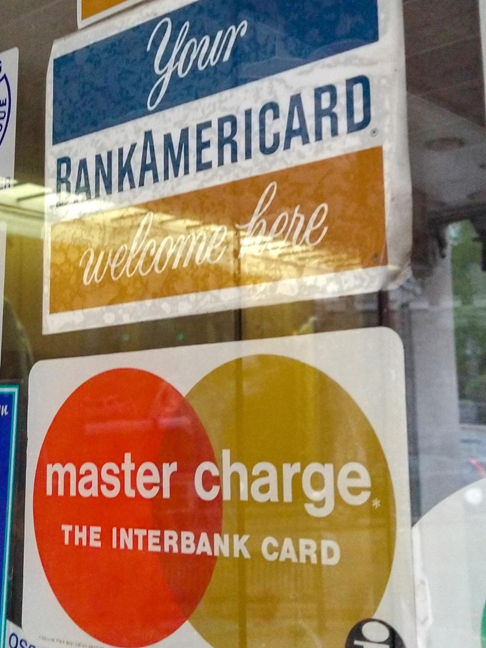
1968 BankAmericard Credit Card and Master Charge decals. So dignified and jetset, don’t you agree?
MasterCard was originally known as Interbank from 1966 to 1969. It then became Master Charge from 1969 to 1979. Master Charge became MasterCard in 1979. Meanwhile the Bankamericard utilized the logo shown on the Varly wall from 1968 until 1976, when it took on the traditional VISA logo that we all know. In fact the BankAmericard officially became Visa in 1976. So if I am adding this up correctly, between the cards’ shared history, and the specific designs displayed, it would appear that this ghost sign was painted between 1969 and 1976…at least this portion of the wall.
I hope I haven’t kept you up till ungodly hours of the night with this one. I had so much fun! This investigation is dedicated to those great signwriters and painters of the past, these good, passionate pharmacists and their families. Your contributions mattered.
Leonard James “Varly” Varlamos passed away in Waterloo, Iowa in 2006 at the age of 85.
Dorothy Eaton Varlamos Zeigler died in 1989.
John L. Truscott was 79 years of age when he passed away in Minnesota in 2017.
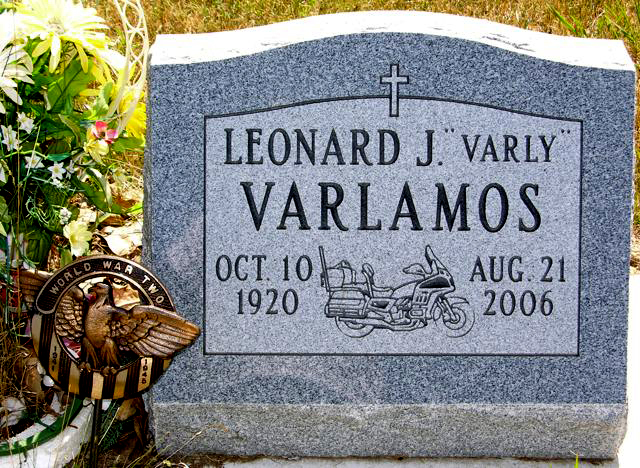
RIP Varly. Photo by Templarion.
I welcome your feedback and contributions to this Ghost Signs of Varly Drug investigation. I want to hear about Varly Drug, Beverly Hills Plaza, surrounding areas, ghost signs and signwriters. Feel free to share thoughts and clues in “Comments.” If any family members have photos to share, please email me so I can include these in the article. Please, please I am asking you to share this article on social media, through email or texts to friends, as I no longer have any social media accounts. I have no way to share my investigations through those platforms.
I invite you to poke around with your flashlight. Investigate. Hide in the shrubbery. Look under these rocks and down those alleyways. I am more than pleased to have you tiptoe about. By the time you head for home, I hope you have been fully Sherlocked and Satiated. Thank you, detective friends.
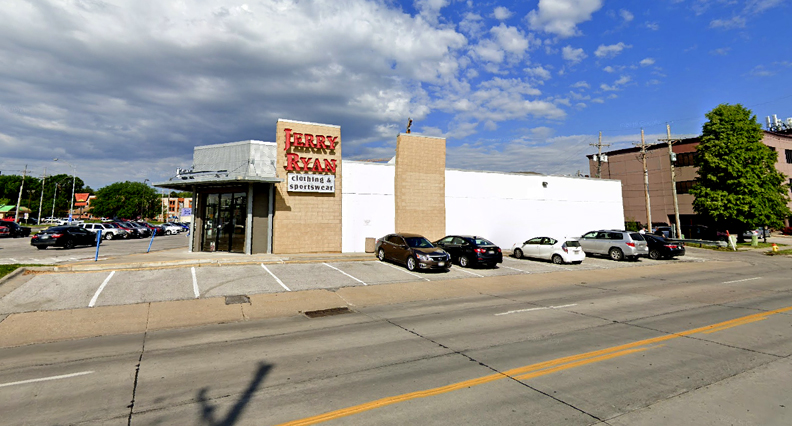
Jerry Ryan Clothing in June of 2019.
If you like what you see, you can keep up with my latest investigations by joining my email group. Click on “Contact” then look for “Sign me up for the Newsletter!” Enter your email address. It will then display “Thank you, your sign-up request was successful!” Make sure to check your email address to confirm. You will get sent email updates every time I have written a new article.
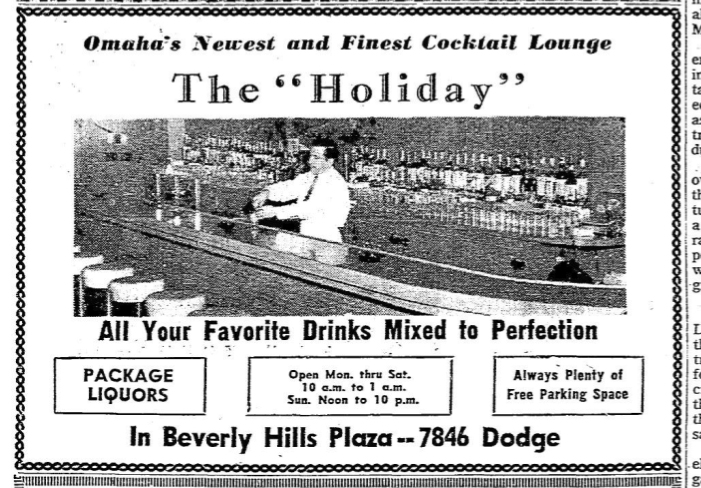
All Hail The Holiday Lounge. Great advertisement from November 2, 1956.
© Miss Cassette and myomahaobsession, 2022. Unauthorized use and/or duplication of this material without express and written permission from this site’s author and/or owner is strictly prohibited. Excerpts and links may be used, provided that full and clear credit is given to Miss Cassette and myomahaobsession with appropriate and specific direction to the original content.
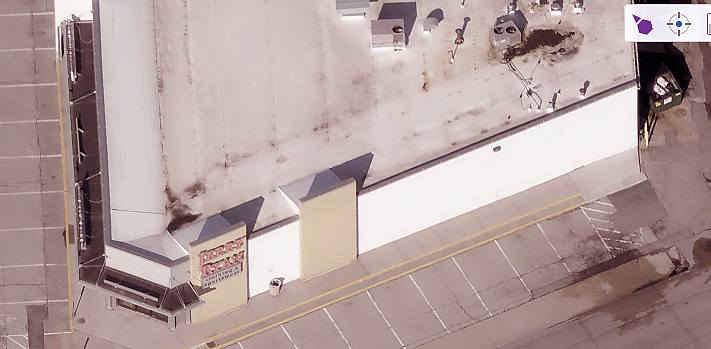
If you are looking for more architectural and Omaha history sleuthing fun, ask your local or big box bookseller for my new book: My Omaha Obsession: Searching for the City. You can also order it through this website. Thank you.
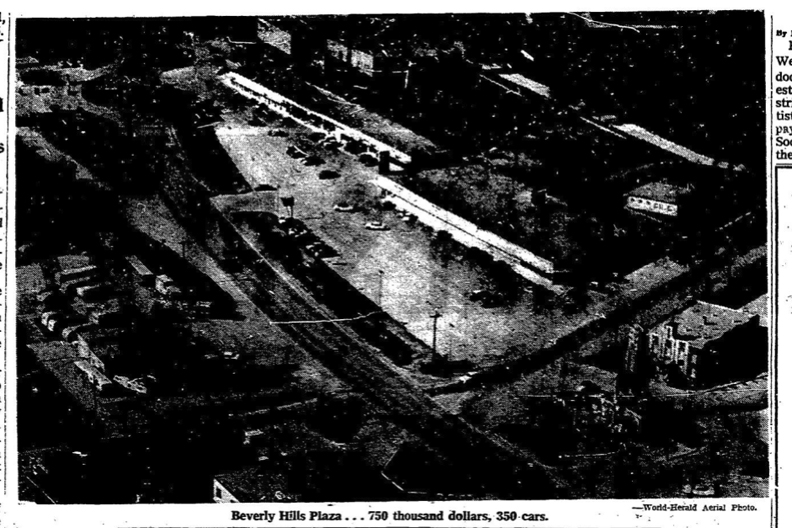
Image borrowed from the OWH. December 1, 1955. This is the one folks—the Vampira late night ghoul shopabout! Enjoy.


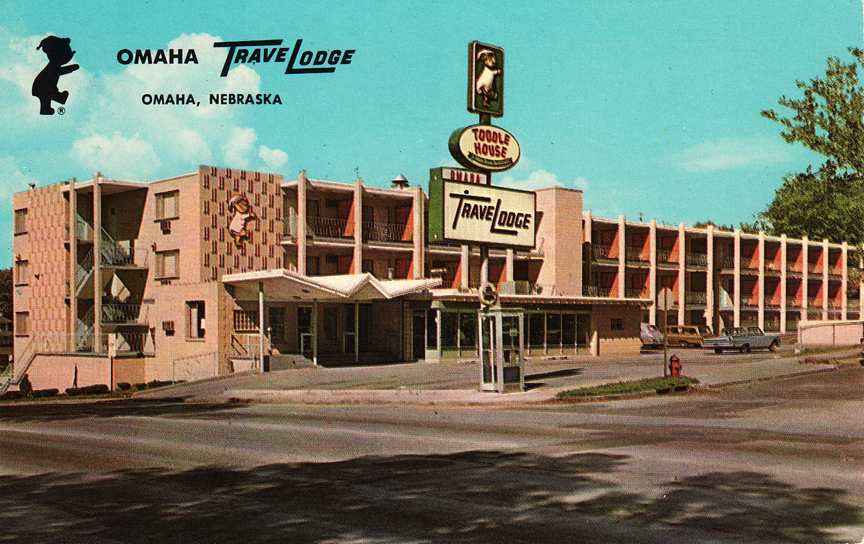
Wow! Seeing the picture of the Dixie Kitchen brought back memories. Mom would take my brothers and I there for lunch after our back to school physicals with Dr. Abts. The lunch we looked forward to, the physicals not so much.
Dad would take the family out to Rose Lodge once in awhile. That was always a treat.
As an aside, the 76th & West Dodge Drive-In was Omaha’s first drive-in. It has the same look and layout that the old Council Bluffs drive-in had.
Thank you Miss Cassette for invoking some sweet memories. Keep up your great work. By the way, your book is fabulous!
I feel like this one was written for me. I know Omaha is a small town but this is my childhood this is my life. My uncles owned the Franco Beauty Salon. My grandfather owned Franco’s hair affair in Benson. In fact, I have a photo of that sign (I think I grabbed it for personal collection from another Omaha site). My mom designed the Benson sign that was up until the shop closed in the 2000’s. I don’t know if she did any of the artwork for the ads but if you are able to share I would absolutely love to share with her
I spent many lunches as a child at B&G as did so many others – I didn’t realize until I was an adult and it was closing that I wasn’t the only one devoted. And many nights at the Holiday Lounge in my 20s.
In the aerial photo of Rose Lodge you can see the backside of an absolute gem that deserves a story… what is now a Men’s Wearhouse, and prior to that I think a Hardee’s, was the fantastic Art Deco styled Grabow’s service station. It was white with red trim and red horizontal striping. The Grabow’s sign was also red and in an iconic early Art Deco font. The facade had curved corners in that Art Moderne streamlined style. There may have been some neon accents. The building was, or seemed, untouched by time, and it was so easy to imagine Bonnie and Clyde or Moe and Addie from Paper Moon pulling in for gas. It was upsetting when it was foolishly demolished for a Hardee’s that soon was out of business. Grabow’s was truly a gem, an important gem.
Does anyone remember the mounted buffalo head in Rose Lodge? Or the Crystal Tree in the New Tower Inn dining room that came from the set of the Julie Andrew’s television variety show?
I must go back and review your whole comment but what is really lighting up the circuit board is the mention if the tree. I believe this is the tree that is locked in my mind but in the wrong location. I had mentioned in the story previous about the Golden Apple restaurant that there was a large tree in there. No one ever remembers what I’m talking about. And somehow I got it in my head that my grandmother had said that tree was the Cottonwood tree from the Blackstone Hotel. But I think That things perhaps got swirled around in my mind. Could it be that this is my tree? I knew it had a dignified past. This is got to be it. Thank you so much!
Yes, I remember the tree at the Golden Apple Restaurant! Oh my gosh, immediately when walking in you knew it was for a very special occasion, for sure.
Love, love, love going down memory lane with the 78th Beverly Hills Plaza and all the surrounding landmarks!
Thanks so much for your wonderful recap and so eloquently taking us back to a very special time and place!
Mary Beth, you really remember the tree? I had started to think I was going crazy. You are the only one. Was it gold? I have started to doubt myself so much that then I thought maybe it was a real tree in the entryway when you first walked in. But I had thought it had been gold inside of the restaurant. Please let me know any details you remember. Even my good friend who used to work there said that he doesn’t remember a tree but that there was some kind of fountain. Thanks for this.
I do! was thinking it was right up near the entry as you walked in… like it was greeting you giving off an upscale vibe. Yes, gold and impressive! My memory says it was three dimensional as opposed to a flat one-dimension type of tree, but I could be wrong on that. The tree makes sense as after all, it was the Golden Apple restaurant. 🙂 I’m sure it was there. It will be interesting to see if your article sparks others’ memories. I wonder if an old review, like from Peter Citron’s guide to 100 Omaha restaurants in 1974, might give a clue. Wasn’t this restaurant around in the 70’s? I did a quick search just now but not hitting on anything that far back.
Hello! I really appreciate you sharing a bit more. Believe me, I have dug through every single golden apple article in the archives. You would think for the magical place that it was, it’s good reputation, and excellent food that there would be more about it, but no. The library does have their menu though. But still nothing about that dang tree.
I figured if anyone could uncover this golden tree it would be you! I will ask my two sisters and see what they remember. Sorry I’m not more help!
At 16:00 you’ll see the Crystal Tree from the set of the Julie Andrew’s hour.
https://youtu.be/yrwf8SOm40E
Paragraph 5… https://omaha.com/news/local/history/new-tower-inns-distinctive-look-location-made-it-a-popular-nightlife-destination/article_815b57a4-1c9a-11ec-aacf-af4a9f0c772f.html
I’d love to know where that Crystal Tree is now.
Yes! Me too.
Yes once upon a time the Dixie Kitchen Sign did slowly turn. It was done in red neon.
Thank you for these clues! I can see it now.
Rose Lodge mention was a blast from the past. Got to go back to read that article. Loved this one. Thank you for your superb investigative work.
Thank you so much, Rita! I think you will like the Rose Lodge article and I’d love to hear your memories.
Back in the 80’s I had some friends who loved to go to the race track. Interesting – they always bought the racing form at Varly’s because it always went on sale there ever day before anywhere else.
Believable! I think we only know the tip of the iceberg on that one. I noticed the race horses in Truscott’s Varly ad.
I love old ghost signs and old signage in general, so I really enjoyed this article. I would love to see you do more articles about old signage.
What memories of Beverly Hills. Went to Dixie Kitchen until it closed with my grandmother Ann Mainelli. Mainelli was part owner of Holiday Bar for many years so thank you for this great history. Kaye Mainelli Bataillon
Hi, please consider ditching style for substance by using black color instead of pale gray for all fonts/postings…. many sites use this gray type, often in equally hard to see small fonts.
…that whine said, some tidbits re: your typically deep dive, literate writing on story about Varly’s.
1-good friend of my sister Joan Olson Larsen & her husb Jan is Cathy Eaton Varlamos (coincidence Eaton maiden name of Leonard V). Cathy wss ‘62 Westside Hi, husb Jim was in my ‘61 class. Jim & Cathy live near my sister who lives in Windsor Colo..
I’ll alert Joan & Jan to share your story in hopes V’s will give you portal to more info.
2-Clubhouse of Indian Hills golfcourse was also residence of mgr; his son is ret’d OPoliceman who lives in Swanson Tower. He told me as a kid he saw (now Iowa) Meskwakee tribe members come retrieve remains of buried tribesmen on course, hence name
Indian Hills.. Forgot OPD man’s name, but I’m sure Swanson T mgr (was David Larson in ?2012) could get you in touch to elaborate.
3-Roffmann’s Deli was the Best!
Owner Len Roffman, ObGyn MD, brother
Blaine “Quincy” R, Pathol. MD, sadly, both fine guys deceased.
4-Yergey’s started un Benson
5-Dixie K towering lightpost sign DID rotate.
6-Aerial pic shows straight shot “Old Dodge
St.” heading directly W ending at 84th
in line w/clubhouse. Old Dodge took a very steep upward turn about 200 ft E of 84th, making its narrow gravel barely 2-lane rd impassable in mud or snow.
7-Mike Ford’s development of Indian Hills was well done. His Swanson Professional Bldg (still standing)
featured 2 floors. with long unbending halls rivaling
the Pentagon’s. First floor mid-bldg entry, E side, had fine coffee/burger place with odd name, “The Umbrella.” Best burger named in honor of his
racehorse, “Umbrella Fella;”
horse was good, but Mike’s Ky Derby winner was
better (“Kaui King,” painting of
which adorns N wall ofBev Hill’s Holiday Lounge).
8- Lazy Leopard Lounge New Tower wss used in film
“To Wong Foo, Thanks for Everything-Julie Newmar”
(1995).
9-Varly’s coffee bar actually also had full soda fountain,
excellent choc milkshakes sometimes made by Len Varlomos in his proper pharmacist’s white uniform.
10-John Truscott’s Varly Drug was well run;
he told me he was moving to MN since
taxes & fees getting too high here.
Had all of the daily racing publ’s;
W Buffett had his own handicapping sheets,
sold at Cris Rexall 50th & Dodge… very accurate… of course.(per my late dad)… when we lived at 61st & Walnut, we used to stoop to pick up thrown out tickets at Ak-Sar-Ben… the www has article on that
hobby, called “stoopiing,” that article said Buffett also did as a lad.
11- As I recall, the space between the two
Bev Hills bldgs was a roadway that connected to the N. backside E-W ‘alley’ for shipping access; that way, easy access for deliv entry-exit.
12- For a few yrs, USPO N. of Varly’s was a Neb DMV location, where I went as late as 1980, later torn down.
13- I’d like to email you to give more info; I don’t do social media, either…Or, are you concerned about
keeping your anonymity?….I’ll probably just
addr. to Miss Cassette & send to OPub Lib, since
I’ve been told that ‘MC’ has been spotted in
such locations… kinda often.
Thanks for your endless research!
Hello Daniel–Thanks for all of the great clues! I will savor and pore over these. Two quick thoughts directed toward me–I have black font everywhere on the site (or it should be!) except for when a person types in to comment. But then it becomes black once a person sends it. Just the way it’s set up. I am not sure if you read the article about my social media accounts being hacked and money stolen but that is why I no longer have social media. https://myomahaobsession.com/2022/04/04/the-my-omaha-obsession-facebook-page-was-hacked/ It was sure for and good long run while we had the My Omaha Obsession page on FB. If you click on “contact” on this website it will direct you to my email, if you lose it. Otherwise it is myomahaobsession@yahoo.com. Thanks so much for all of your great additions and feedback.
I grew up in Omaha, NE and do recall these memories, especially the Dixie Kitchen. I remember Peony Park and my mother would go to these dance events to meet men. Thank you for posting the great memories and I now reside in Northern California at the age of 64. January 9, 2023.
Just a note on “ol’ signpainters”…….A couple, from what I call the old days, were Bob Story and Ed Voselka. Both old skool sign painters that were known for painting signage on buildings back in those days. No idea if either of these were the painters of the Varly wall. Both of those two gents had several signs around South O that they had painted long long ago, and up until recently, could still be seen in “ghost” form.
In modern times, sign painters would use Sign Painters 1 Shot enamel paint. In the old days, pretty much any oil based paint would be used. The sign painters would use any available brush they had. The only specific brush in the old realm of sign painting was the pin stripers brush. By pin striping, think Von Dutch, or Ed Roth. Pin Striping is a whole ‘nother art form !! Two versions of the pin stripers brush……sword and dagger.
I knew Bob Story fairly well, Ed Voselka not so much and only met him one time. Bob was originally from Des Moines and was an All State football player and headed to the University of Iowa until WWII happened. He then joined the US Army and the 87th Infantry, the Golden Acorns. Private Robert Story stormed the beach at Normandy, and was a true American hero, yet nobody knew it and he never spoke of it. His unit lost 75% of it’s numbers on D-Day. Bob made it home and returned to his life and moved to Omaha where he took up sign painting. He’d call himself “The Ol’ Sign Painter Story”. The only man I ever knew who, at 70 years old, was still standing on a ladder and hand painting signage on a semi truck trailer. In 95 degree heat.
Oddly enough, those ol’ signpainters were also responsible for 95% of the “trench art” and Bomber Nose Art in WWII. Bomber Nose Art….think “Memphis Belle”. Pin-up girls, mostly, as bombers were referred to in the female sense the same as ships were. If they found a soldier with an ounce of artistic ability, they handed him a bucket of paint, some gasoline to thin it out, and a brush. The pilots and tank drivers told him they wanted this or that on the nose of the bomber, or tank……and he went to town painting it. After the war, these soldiers and sailors suddenly had a new skill or profession………sign painting !
These ol’ signpainters are mostly gone now, with the art nearly lost to the age of the computer. I began in the sign business in 1992, just as the computerized sign making industry was exploding. Still here, now surrounded by computers, sign cutters and sign printers, and waxing poetic about history and ol’ signpainters. Wishing that the art and originality of hand painted signs hadn’t went the way of the Edsel.
I read your article and was touched that you had discovered a history of my father and John’s Varly Drug. You questioned whether Big John’s Pharmacy in Council Bluffs was run by the same pharmacist, and I can confirm that my father owned both businesses.
I enjoyed your article, thanks for writing it!
Fascinating article which brought back many old memories… A few notes on the comments above, and some notes in general…
There were Nebraska State Offices on the west side of 78th Street between Dodge and Cass. The Nebraska State Patrol had their Troop A Headquarters there until the NSP Troop A HQ was built just south of 108th and L Street. As late as the late 1980s, I recall attending Implied Consent Hearings at the 78th Street State Offices as a police officer.
The New Tower Inn: My Mom used to be a singer at the Bird Cage Lounge during the 60s. She met the man who became my stepfather there. My stepfather held many business meetings at the New Tower when business associates from out of town gathered Omaha. The Crystal Tree was indeed in the restaurant at the New Tower and had been a feature of the Julie Andrews Show which aired during the early 70s. …And by the way, you’re spot on in describing Frank Blazek. Even as a kid, I sensed he was a sleaze! (Did I say that?)
The Dixie Kitchen: I loved that restaurant as a kid. If you were good, and ate your meal, you could stop by the Treasure Chest and select a toy from the goodies in the chest. My last visit to the Dixie Kitchen was in the Summer of 1978 when I took a date there for dinner.
I think the soda fountain at Varley drugs was where I had my first Cherry Coke as a kid. Our family moved to the 77th and Cass Street area in about 1955. I attended Underwood Elementary School which was on land east of the creek and railroad tracks from the New Tower. Frank Blazek’s daughter was in my class. Before the New Tower existed I have a vague memory of trailers occupying that ground. I also remember a cavernous storm sewer that emptied into the creek that some of us would walk through. The first job I had was at Dixie Kitchen and it was owned by a Jewish fellow named Fisher and the main cook was a Chinese fellow. Interesting cross cultural approach to Southern cooking! At age 15, I sometimes got off work after the bar rush and would walk home from there. The bars closed at 1:00 a.m. And I felt pretty big going home on my own around 2:00 in the morning. I remember getting caught sneaking into the drive-in theater as a kid. There was an open field with a lot of scrub brush behind it and one day we saw the police arrest two criminals who surrendered in that field. -Stuart J.
Back in 1965 Roffman Deli was one of my favorite spots even though I never once walked through the door. I was working at KMTV and Cal Kirshen was one of our announcers. When Cal worked Saturday nights he would call the station before he came in and take our orders from Roffman’s. As I recall, I usually ordered a pastrami sandwich on rye and potato salad. Some of the best food I ever ate in my life.
Aaaah…that sounds absolutely fantastic. I wish I could’ve known it as well. I have heard only the best things of that deli.
A wonderful narative. Thank you so much! I am Don Varlamos, the younger son of Dorothy and Lenoard.
some of the history I didnt know but much I’ll never forget having grown up there.
Thank you so much for writing in! I dreamed you must have spent so much time there. What a childhood!
Before the Beverly Hills Plaza, B&G was a small drive-in up Dodge ~ 88th? We used to stop and have “beegees,” what we called the loose meat beef sandwiches.
Also, Roffman’s eventually had a liquor license, as well. I remember Norm Roffman was a friend of my father’s.
I remember Varley Drug – the reason I came across your wonderful article.
Thanks for the memories!
We just moved my father back to Omaha recently and he asked for a “beegee’s sandwich”! Amazing. Thanks for sharing, Moira.